EINSTEIN Agro
This platform provides an inventory of genetic resources for micronutrient-rich crops essential for healthy food production. You can search the table using any term, and it will instantly filter results across all cells.
Additionally, by clicking on a specific organic product, you can access detailed information, including:
- Producers
- Crop rotation practices
- Bed preparation techniques
- Fertilization methods
- Sowing guidelines
- Care and maintenance
- Irrigation requirements
- Harvest procedures
Explore our EINSTEIN Agro platform to discover valuable insights into sustainable and nutrient-rich crop production!
| Product type | Organic product | Availability in Vojvodina |
|---|---|---|
| aromatic crop | Chamomile | yes |
| aromatic crop | Dill | yes |
| aromatic crop | Immortelle | yes |
| aromatic crop | Melissa | yes |
| aromatic crop | Mint / Peppermint | yes |
| aromatic crop | Parsley Leaf | yes |
| Cereals | Barley | yes |
| Cereals | Buckwheat | no |
| Cereals | Maize | yes |
| Cereals | Oat | yes |
| Cereals | Rye | yes |
| Cereals | Spelt | yes |
| Cereals | Wheat | yes |
| fruit | Apple | yes |
| fruit | Aronia | yes |
| fruit | Blackberry | no |
| fruit | Sour Cherry | no |
| fruit | Sweet Cherry | yes |
| fruit | Dogwood | no |
| fruit | Grapes | yes |
| fruit | Hazelnut | yes |
| fruit | Peach | yes |
| fruit | Pear | yes |
| fruit | Plum | yes |
| fruit | Raspberry | yes |
| fruit | Rosehip | yes |
| fruit | Sambucus | no |
| fruit | Strawberry | yes |
| fruit | Walnut | no |
| fruit | Wild Blackberry | no |
| fruit | Wild Blueberry | no |
| fruit | Wild Strawberry | no |
| industrial crop | Alfalfa | yes |
| industrial crop | Hemp (seeds) | no |
| industrial crop | Mustard Plant | yes |
| industrial crop | Sunflower | yes |
| mushroom | Chanterelle | no |
| mushroom | Mushrooms | no |
| mushroom | Oyster Mushrooms | no |
| Protein sources | Beans | yes |
| Protein sources | Chickpeas | yes |
| Protein sources | Faba Bean | yes |
| Protein sources | Lentil | yes |
| Protein sources | Peas | no |
| Protein sources | Soy | yes |
| vegetable | Arugula | no |
| vegetable | Beetroot | yes |
| vegetable | Broccoli | yes |
| vegetable | Cabbage | yes |
| vegetable | Melon | no |
| vegetable | Carrot | yes |
| vegetable | Cauliflower | yes |
| vegetable | Celery | yes |
| vegetable | Chard | yes |
| vegetable | Cucumber | yes |
| vegetable | Garlic | yes |
| vegetable | Green Beans | no |
| vegetable | Kohlrabi | yes |
| vegetable | Leek | yes |
| vegetable | Lettuce | yes |
| vegetable | Okra | yes |
| vegetable | Onion | yes |
| vegetable | Paprika | yes |
| vegetable | Parsnip | yes |
| vegetable | Pumpkin | yes |
| vegetable | Radish | yes |
| vegetable | Spinach | yes |
| vegetable | Tomato | yes |
| vegetable | Watermelon | no |
| vegetable | Wild Garlic | no |
| vegetable | Zucchini | yes |
| vegetable | Potato | yes |
| vegetable | Rucola | yes |
Sunflower

Photo Credits: https://jamescressflorist.com
Producers
- Ignjat Jurišić
Fruškogorska 39, 22213 Šuljam, Serbia
Phone: +38164 6428250
Email: zlatnozrnosuljam@gmail.com - Josip Mamužić
Mamužićev put 68, 24215 Ljutovo, Serbia
Phone: +381641196826
Email: f.mamuzic2@gmail.com - LoginEKO doo
Tiski red 117, 23207 Aradac, Serbia
Website: https://www.logineko.com
General Information
- Total Area in Serbia: 451 ha
- Number of Varieties: 285
- Family: Asteraceae
- Genus: Heliantus
- Species: Heliantus annus
- Product Type: Industrial crop
Rotation
Sunflower must be grown in a crop rotation to prevent diseases. The economically significant disease is Sclerotinia, which reduces yields. Additional notes:
- Sunflower moth caterpillars pupate in the webbing on the flower head or descend to the soil.
- Sunflower should be planted on the same plot only after 4-5 years.
Preceding Crops
- Soybeans and oilseed rape are not suitable due to similar diseases.
- Alfalfa and grass with deep roots that dry out deeper soil layers are unsuitable.
Bed Preparation
- Basic autumn and winter plowing to a depth of 25 cm.
- Pre-sowing tillage in spring involves two passes: one with harrows (when the soil is dry) and one before sowing using leveling tools.
Fertilization
Fertilize the soil with manure every 4-5 years, at 30-50 t/ha.
Sowing
- Only declared seeds (hybrids) with germination rates of 80% or higher (typically above 90%) are used.
- Sowing time: When the soil temperature at the sowing layer is 8-10°C.
- Sowing depth: 4-6 cm, with rows spaced 70 cm apart (depending on the hybrid).
Care
- Rare breaking of the soil surface layer.
- Mechanical weed control involves two inter-row cultivations followed by manual hoeing.
- One inter-row cultivation is recommended to break the cover and achieve optimal humidity.
Irrigation
Not necessary, as sunflower is resistant to drought. Excess irrigation can cause diseases.
Harvest
- At technological maturity, leaves fall from the stem.
- Grain water content starts at 14% and ends at 10%.
- For long-term storage, maintain grain humidity at 8%; otherwise, drying or immediate processing is required.
- Combine settings (adapter-thresher) are crucial to minimize seed damage.
Chamomile
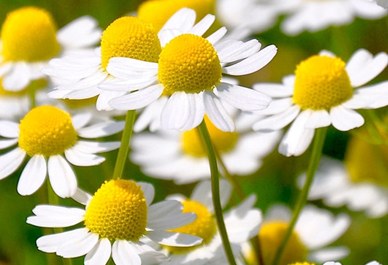
Photo Credits: https://growagoodlife.com
Producers
- YU-DNI d.o.o
Banatska Topola, Kikinda, Serbia
Phone: +381 60 587 98 88
Email: office@yu-dni.rs
General Information
- Total Area in Serbia: / ha
- Number of Varieties: /
- Family: Asteraceae
- Genus: Matricaria
- Species: Matricaria chamomilla L. (syn. Matricaria recutita)
- Product Type: Aromatic crop
Rotation
Chamomile fits well into diverse rotations, contributing to weed control and reducing soil-borne pathogens. Avoid repeating chamomile or other Asteraceae crops on the same field for at least 4 years.
Rotational Crops: cereals (spelt, oat), legumes (vetch, clover), oil crops (flax, sunflower)
Preceding Crops
- Legumes (vetch, clover, alfalfa) – enrich soil nitrogen
- Cereals (spelt, rye) – reduce weed pressure
- Buckwheat or phacelia – support pollinators and improve soil texture
Bed Preparation
- Preferred soil type: light, well-drained, loamy or sandy soils
- Ideal pH: 6.0–7.0
- Deep plowing (25–30 cm) in autumn, followed by discing in spring
- Final tillage: fine, firm seedbed using rotary harrow or vibro-cultivator
- Flat or slightly raised beds depending on soil moisture and erosion risk
Fertilization
- Composted manure or vermicompost (10–15 t/ha) before sowing
- Green manure (e.g., clover) in previous season beneficial
- Optional: pelletized organic fertilizers or compost teas based on soil analysis
Establishment
- Direct sowing in early spring (March–April) or late autumn (October–November)
- Seeding rate: 1–2 kg/ha
- Row spacing: 25–30 cm
- Depth: surface-sown or max 0.5 cm, firmed with a roller
- Avoid over-compaction to ensure seed-to-soil contact
Care
- Weed control: manual hoeing, mechanical inter-row cultivation, flame weeding in early stages
- Use of cover crops or mulch in inter-rows (e.g., straw or chopped hay)
- Monitoring pests and diseases – aphids and leafhoppers may appear
- Companion planting (e.g. yarrow or calendula) to deter insects
- Biological control: e.g. releasing ladybugs for aphids
- Use of biopreparations: neem oil, garlic extract, Bacillus thuringiensis
Irrigation
Usually not required if sown in early spring or autumn in humid regions. If necessary, use drip or sprinkler irrigation during prolonged drought or early flowering stage. Total requirement: 100–150 mm if rainfall is inadequate.
Harvest
- Time: when 50–70% of flowers are open (optimum oil content)
- Manual picking for premium dried flower markets
- Chamomile harvester machines for bulk production
- Drying: immediately post-harvest in shaded, ventilated area, temperature below 40°C
- Target moisture: 8–10%
- Storage: in paper or cloth bags, away from light and humidity
Dill

Photo Credits: https://www.bhg.com
Producers
- YU-DNI d.o.o
Banatska Topola, Kikinda, Serbia
Phone: +381 60 587 98 88
Email: office@yu-dni.rs
General Information
- Total Area in Serbia: / ha
- Number of Varieties: /
- Family: Apiaceae
- Genus: Anethum
- Species: Anethum graveolens L.
- Product Type: Aromatic crop
Rotation
Dill should be included in rotations to prevent pests and diseases common to the Apiaceae family. Avoid repeating dill, parsley, celery, or carrot on the same field within 3–4 years.
Excellent previous crops: cereals (spelt, rye), legumes (vetch, peas), flax
Preceding Crops
- Legumes – improve nitrogen content and suppress weeds
- Cereals – leave clean fields with reduced weed seeds
- Early harvested vegetables or buckwheat
Bed Preparation
- Autumn plowing (25–30 cm deep), followed by fine seedbed preparation in spring
- Final preparation: 1–2 passes with a harrow to ensure a loose, crumbly structure
- Flat or raised beds depending on drainage and weed control needs
Fertilization
- Composted farmyard manure (10–15 t/ha), applied 1 month before sowing
- Optionally: biofertilizers or plant-based compost teas
- Avoid over-fertilization to prevent lodging and excessive vegetative growth
Establishment
- Direct seeding is standard
- Spring sowing: March–April
- Optional late summer sowing: August (for autumn harvest)
- Seeding rate: 10–12 kg/ha (leaf), 6–8 kg/ha (seed)
- Row spacing: 20–25 cm (leaf), 30–40 cm (seed)
- Depth: 1.0–1.5 cm
- Germination in 10–14 days, best at 10–20°C
Care
- Weed control crucial in early stages – manual hoeing, inter-row cultivation, or flame weeding
- Thinning may be necessary to reduce plant competition
- Monitor for aphids, carrot fly, downy mildew – use biocontrol or organic sprays
- Intercropping with onion or coriander can reduce pests
Irrigation
Needed during germination, leaf growth, and flowering. Drip irrigation is preferred to reduce leaf wetness and fungal risk. Water requirements: 100–150 mm depending on rainfall. Avoid overhead irrigation before harvest to reduce disease risk.
Harvest
- For fresh leaves: Begin cutting when plants are 20–25 cm tall, repeat every 10–15 days
- For seeds: Harvest when 60–70% of seeds turn brown, before shattering begins (July–August)
- Drying: Leaves: shade-dried at 35–40°C; Seeds: field-dried or forced-air drying
- Final moisture: Leaves: 10–12%; Seeds: 8–10%
Immortelle

Photo Credits: https://botanicalarchive.com
Producers
- YU-DNI d.o.o
Banatska Topola, Kikinda, Serbia
Phone: +381 60 587 98 88
Email: office@yu-dni.rs
General Information
- Total Area in Serbia: / ha
- Number of Varieties: /
- Family: Asteraceae
- Genus: Helichrysum
- Species: Helichrysum italicum (syn. Helichrysum angustifolium)
- Product Type: Aromatic crop
Rotation
Immortelle is a perennial crop typically kept on the same field for 4–6 years. It should not follow other Asteraceae species due to shared pests and diseases. After removal, the field is rotated with cereals or legumes to restore soil.
Preceding Crops
- Legumes such as clover or alfalfa – enrich soil and suppress weeds
- Cereals like rye or spelt – provide clean fields with low pest pressure
Bed Preparation
- Deep plowing in autumn, followed by surface tillage in spring or late summer
- Raised or slightly inclined beds to prevent waterlogging and support root development
- Fine seedbed is essential for good rooting of seedlings or cuttings
Fertilization
- Composted manure or plant-based compost: 10–15 t/ha
- Optional additions: fermented plant extracts or liquid compost teas before planting and during early vegetative growth
- Soil analysis used to guide nutrient management
Establishment
- Propagated through seedlings or cuttings (not by direct seeding)
- Seedlings raised in nurseries/greenhouses and transplanted at 8–10 cm height
- Transplanting in early spring (April) or early autumn (September)
- Spacing: 40 cm within row, 70 cm between rows (30,000–40,000 plants/ha)
Care
- Manual or mechanical weed control, especially in the first year
- Mulching (straw or organic foil) for moisture retention and weed suppression
- Generally pest-resistant; monitor for root rot in humid zones
- Foliar feeding with organic bio-stimulants improves vigor and oil content
- Pruning after flowering stimulates regrowth and maintains shape
Irrigation
Once established, immortelle is drought-tolerant and usually doesn’t require irrigation. In the first year or dry conditions, use drip irrigation to support rooting. Water needs: 100–150 mm during dry seasons.
Harvest
- Harvest 1–2 times/year depending on climate
- First cut: June–July (when most flowers are open)
- Optional second cut: late August in long-season regions
- Manual or mechanical harvest (upper green parts)
- Fresh biomass processed by steam distillation or dried below 40°C
- Oil yield: 3–8 kg/ha depending on genotype and plantation age
Melissa (Lemon Balm)
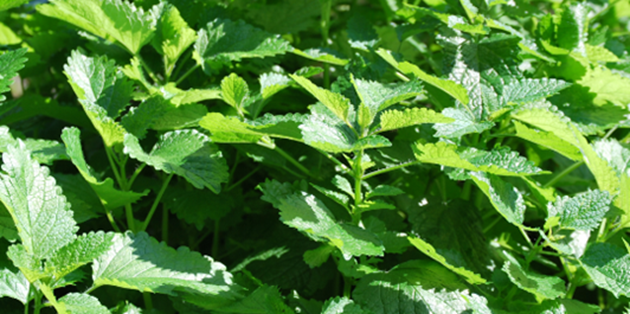
Photo Credits: terrepromise.ca
Producers
- YU-DNI d.o.o
Banatska Topola, Kikinda, Serbia
Phone: +381 60 587 98 88
Email: office@yu-dni.rs
General Information
- Total Area in Serbia: / ha
- Number of Varieties: /
- Family: Lamiaceae
- Genus: Melissa
- Species: Melissa officinalis
- Product Type: Aromatic crop
Rotation
Melissa is a perennial crop typically kept on the same field for 4–6 years. It should not follow other Lamiaceae species due to shared pests and diseases. After removal, the field is rotated with cereals or legumes to restore soil balance.
Preceding Crops
- Legumes such as clover or alfalfa – enrich the soil and suppress weeds
- Cereals like rye or spelt – provide clean fields and low pest pressure
Bed Preparation
- Deep plowing in autumn, followed by surface tillage in spring or late summer
- Raised or slightly inclined beds to prevent waterlogging and support root development
- A fine seedbed is essential for good rooting of seedlings or cuttings
Fertilization
- Composted manure or plant-based compost: 10–15 t/ha
- Additional nutrients via fermented plant extracts or compost teas in spring
- Soil analysis guides balanced nutrient management
Establishment
- Propagated through seedlings or cuttings (not by direct seeding)
- Seedlings raised in nurseries and transplanted at 8–10 cm height
- Transplanting in early spring (April) or early autumn (September)
- Spacing: 40 cm within rows, 70 cm between rows (30,000–40,000 plants/ha)
Care
- Manual or mechanical weed control, especially in the first year
- Mulching (straw or organic foil) for moisture retention and weed suppression
- Generally pest-resistant; monitor for root rot in humid areas
- Foliar feeding with bio-stimulants enhances oil content and vigor
- Pruning after flowering stimulates regrowth and maintains shape
Irrigation
Once established, lemon balm is drought-tolerant. In the first year or in dry regions, drip irrigation may be used. Seasonal requirement: 100–150 mm in dry years.
Harvest
- Harvest 1–2 times/year depending on region and weather
- First cut: June–July (when most flowers are open)
- Optional second cut: late August
- Harvesting is manual or mechanical (cutting upper green parts)
- Fresh biomass is steam-distilled or dried at <40°C
- Oil yield varies depending on variety and plantation age
Mint / Peppermint

Photo Credits: Kitchen Garden Seeds, Edulis
Producers
- YU-DNI d.o.o
Banatska Topola, Kikinda, Serbia
Phone: +381 60 587 98 88
Email: office@yu-dni.rs - PG Janoš Farago
Veliki put 212, Orom, Serbia
Phone: +381 62 8313085
Email: janos.farago@gmx.de
General Information
- Total Area in Serbia: / ha
- Number of Varieties: /
- Family: Lamiaceae
- Genus: Mentha
- Species: Mentha × piperita, Mentha arvensis
- Product Type: Aromatic crop
Rotation
Mint is typically kept in the same field for 3–4 years. It should not follow itself or other Lamiaceae species to avoid disease buildup.
Preceding Crops
- Cereals (rye, spelt) and legumes (vetch, clover) – suppress weeds and improve nitrogen
- Avoid after vegetables prone to root diseases
Bed Preparation
- Deep plowing in autumn followed by cultivation and harrowing in spring
- Well-drained, slightly raised beds preferred in heavy soils or rainy areas
- Good drainage is essential for root health
Fertilization
- Composted manure (10–20 t/ha) before planting
- Supplement with fermented plant extracts or certified organic fertilizers based on soil tests
- Excess nitrogen should be avoided to prevent disease-prone growth with low oil content
Establishment
- Planted using rhizome cuttings, stolons, or rooted transplants
- Planting: early spring (March–April) or early autumn (September)
- Spacing: 40–50 cm between rows, 30–40 cm within rows (50,000–70,000 plants/ha)
Care
- Intensive weed control in the first year: hoeing, shallow cultivation, mulching
- Monitor for rust, powdery mildew, and root rot
- Use of biopesticides and resistant varieties recommended
- Mechanical topping after the first harvest promotes tillering and weed suppression
Irrigation
High water requirements during growth and pre-flowering. Use drip or sprinkler irrigation. Optimal seasonal need: 300–400 mm. Stop irrigation several days before harvest to boost oil content.
Harvest
- Harvest at flowering start for peak oil content – usually in June and again in August
- Mechanical cutting 5–8 cm above ground
- Biomass used for steam distillation or shade drying
- Oil yield: 40–80 kg/ha depending on variety and conditions
- Dried leaves stored at 10–12% moisture in ventilated, shaded areas
Parsley Leaf
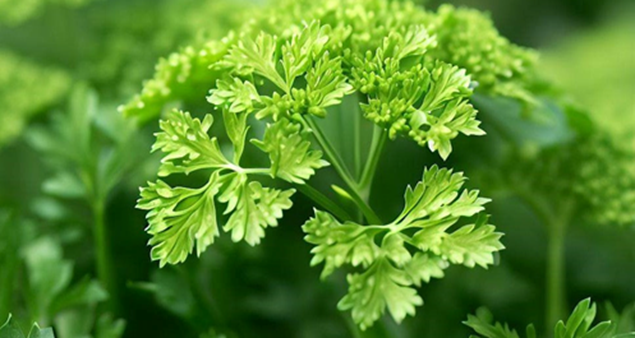
Photo Credits: myseeds.co
Producers
- Data not available
General Information
- Total Area in Serbia: / ha
- Number of Varieties: 14
- Family: Apiaceae
- Genus: Petroselinum
- Species: Petroselinum crispum var. neapolitanum
- Product Type: Aromatic crop
Rotation
Parsley should not be grown on the same field more than once every four years. It must not follow celery, carrot, or other Apiaceae crops to prevent disease buildup.
Preceding Crops
- Cereals (rye, spelt)
- Legumes (vetch, clover) – improve soil fertility and reduce weed pressure
Bed Preparation
- Deep plowing in autumn, fine seedbed preparation in early spring
- Firm, level seedbed with good crumb structure for uniform germination
- Raised beds recommended in heavy soils to prevent water stagnation
Fertilization
- Composted manure: 15–20 t/ha before sowing
- Additional inputs: compost, fermented extracts, or certified organic fertilizers (based on soil tests)
- Limit nitrogen to avoid excessive leaf mass and loss of aroma
Establishment
- Direct sowing: March–April (spring) or late August (autumn)
- Seeding rate: 6–8 kg/ha
- Row spacing: 20–30 cm
- Seeding depth: 1.5–2 cm
- Germination time: 18–25 days depending on temperature and moisture
Care
- Weed control critical early due to slow initial growth
- Hoeing and shallow cultivation standard; mulching also used
- Monitor for aphids, Septoria leaf spot, and leaf miners
- Organic controls: copper-based sprays, neem, and intercropping
Irrigation
Parsley has shallow roots and requires frequent, moderate irrigation. Drip or overhead systems are common. Water requirement: 250–350 mm per cycle. Reduce irrigation before harvest to improve aroma and leaf firmness.
Harvest
- First harvest: 70–80 days after emergence
- Manual or mechanical cutting: 3–5 cm above soil surface
- Multiple harvests possible every 25–40 days
- Post-harvest options: fresh packing, drying, or freezing
- Drying temperature: max 35–40°C
- Final moisture: 10–12% for storage
Barley
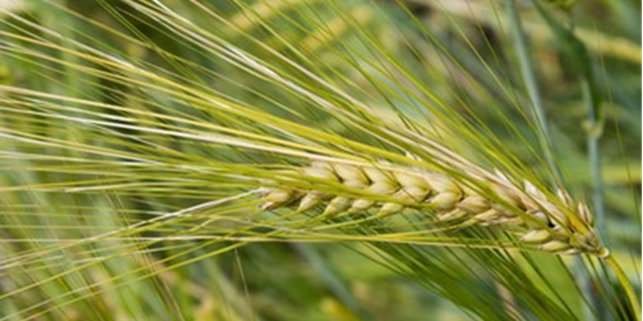
Photo Credits: Shutterstock
Producers
- Ecoagri Serbia d.o.o.
Ekstravilan bb, 26340 Bela Crkva, Serbia
Phone: 013/851211, 013/851-041
Website: www.ecoagri.rs - PG Tružinski Sabolč
Glavna 55, Bačka Topola, Serbia
Phone: +381 63 50 29 03
Email: abc@tippnet.rs
General Information
- Total Area in Serbia: 419 ha
- Number of Varieties: 91
- Family: Poaceae
- Genus: Hordeum
- Species: Hordeum vulgare L.
- Product Type: Cereals
Rotation
Barley fits well into organic rotations and is typically grown after legumes, oil crops, or root crops. It helps break disease cycles and suppress weeds. It is not grown more than once every 3–4 years on the same plot to avoid cereal fatigue.
Preceding Crops
- Legumes (clover, field pea, vetch) – improve soil nitrogen and structure
- Oilseed crops (sunflower, flax)
- Avoid planting after cereals to reduce risk of soil-borne diseases
Bed Preparation
- Plow in late summer or early autumn and allow soil to settle
- Shallow cultivation before sowing for a firm, fine-textured seedbed
- Ensure good seed-to-soil contact for strong germination and tillering
Fertilization
- Apply 10–15 t/ha of composted manure or mature plant compost before plowing
- Additional inputs (e.g., pelletized organic fertilizers, rock phosphate) based on soil tests
- Avoid excess nitrogen to reduce risk of lodging
Establishment
- Winter barley: sow from late September to mid-October
- Spring barley: sow from mid-February to mid-March
- Seeding rate: 180–220 kg/ha
- Row spacing: 12–15 cm
- Seeding depth: 3–5 cm depending on soil type and moisture
Care
- Weed control: rotation, competitive varieties, mechanical inter-row cultivation
- Use of harrowing or rolling pre-/post-emergence to suppress weeds
- Monitor for aphids, powdery mildew, and leaf rust
- Approved organic seed treatments and bio-fungicides can be used
Irrigation
Typically rainfed. In dry years, supplementary irrigation may be needed during tillering and heading stages. Total seasonal water need: 300–400 mm. Overhead irrigation systems used where available.
Harvest
- Winter barley: harvest in June
- Spring barley: harvest in July
- Grain moisture should fall below 14% before harvesting
- Combine harvesting is standard; straw is baled for mulch or bedding
- Grain is cleaned and dried to 12–13% moisture
- End uses: food-grade, malting, organic flour, or livestock feed
Buckwheat
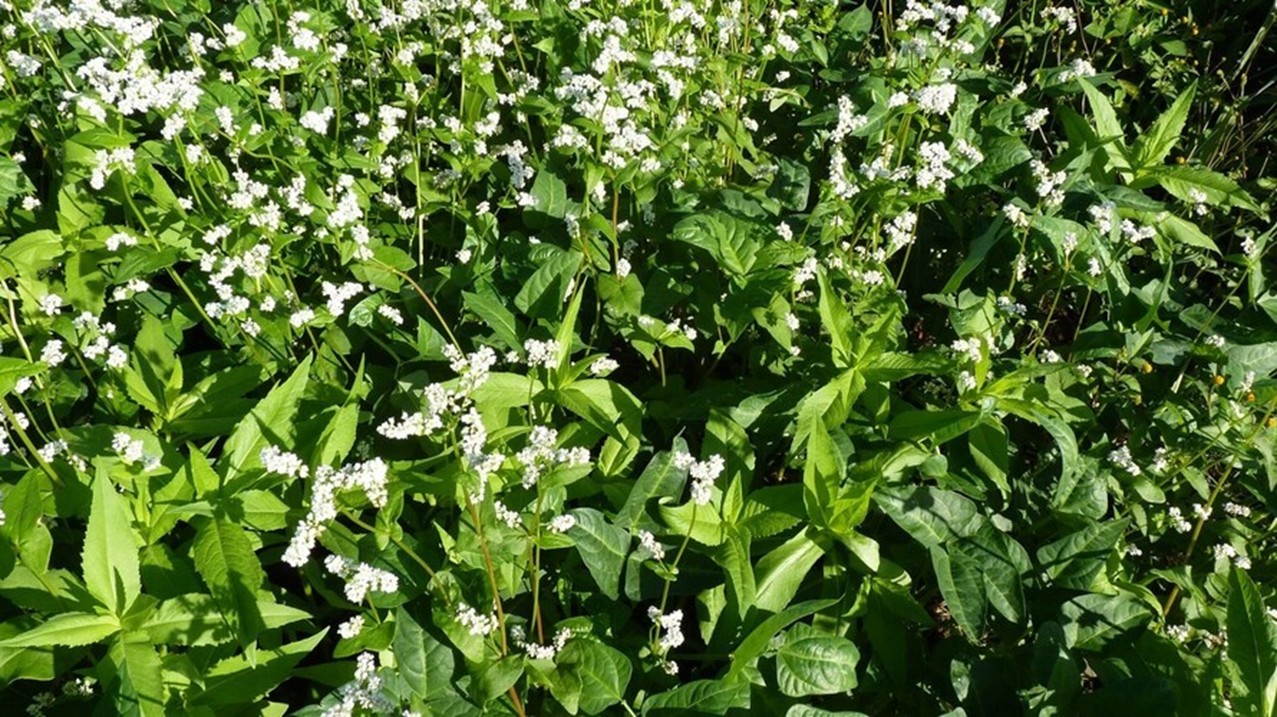
Photo Credits: Wiktrop
Producers
- Data not available
General Information
- Total Area in Serbia: / ha
- Number of Varieties: /
- Family: Polygonaceae
- Genus: Fagopyrum
- Species: Fagopyrum esculentum Moench
- Product Type: Cereals
Rotation
Buckwheat is used as a rotation crop to break pest and disease cycles and suppress weeds. It fits well after early-harvested vegetables or cereals and before autumn crops. Not demanding, it can grow on poor soils and should not be planted repeatedly on the same field within three years.
Preceding Crops
- Early potatoes, peas, or barley – ensure clean soil and early sowing
- Avoid after crops heavily infested with perennial weeds
Bed Preparation
- Light plowing followed by shallow cultivation to preserve moisture
- Fine, firm seedbed essential for small seeds
- No deep tillage required – ideal for reduced-input systems
Fertilization
- Low fertilization need – apply 5–10 t/ha of composted manure before sowing
- Avoid excess nitrogen to prevent lodging and reduced grain yield
Establishment
- Sow mid-May to early June when soil temperature is above 10°C
- Seeding rate: 80–100 kg/ha
- Row spacing: 12–15 cm
- Sowing depth: 3–5 cm
- High seeding rate ensures fast canopy closure due to low tillering
Care
- Fast-growing but sensitive to early weed competition
- Timely sowing and clean seedbeds are essential
- No post-emergent herbicides allowed in organic production
- Low pest/disease pressure; monitor for aphids and fungal blight in wet conditions
- No thinning or topping required
Irrigation
Generally not irrigated. In dry years, light irrigation during flowering may improve seed set. Avoid excess moisture as it hampers pollination and seed development.
Harvest
- Harvest 70–90 days after sowing (typically August)
- Harvest when ~75% of seeds have turned brown
- Can be windrowed or directly combined
- Grain must be dried to below 13% moisture
- Prone to seed shattering — harvest timing is critical
Maize
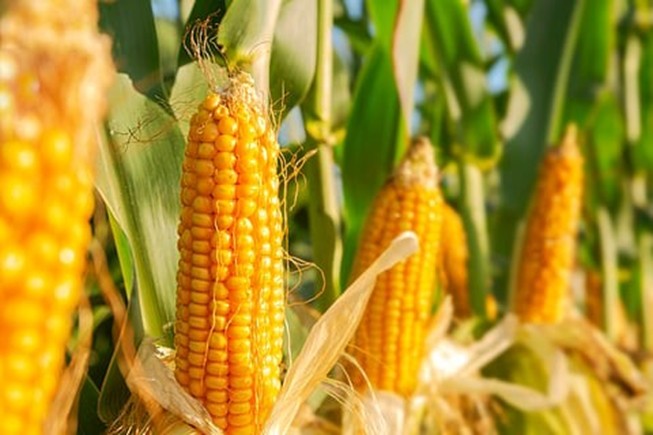
Photo Credits: Down to Earth
Producers
- Ecoagri Serbia d.o.o.
Ekstravilan bb, 26340 Bela Crkva, Serbia
Phone: 013/851211, 013/851-041
Website: www.ecoagri.rs - PG Bojana Maljković
Kralja Petra I 20, Banatsko Karađorđevo, Žitište, Serbia
Phone: +381 65 83 52 911 - Univerexport d.o.o.
Sentandrejski put 165, Novi Sad, Serbia
Phone: +381 64 850 1346
General Information
- Total Area in Serbia: 420 ha
- Number of Varieties: 536
- Family: Poaceae
- Genus: Zea
- Species: Zea mays
- Product Type: Industrial crop / Food crop
Rotation
Maize must be included in a crop rotation system to maintain soil fertility and prevent pest and disease buildup. Continuous maize cropping is discouraged due to increased risk of pest infestation (e.g., wireworms, western corn rootworm) and nutrient depletion. It should not be grown on the same plot more than once every 3–4 years.
Preceding Crops
- Ideal: Legumes (clover, vetch, peas, beans) – improve nitrogen
- Small grains (wheat, barley) – reduce weed pressure and pests
- Unsuitable: Maize (monoculture), sunflower (Fusarium risk)
Bed Preparation
- Deep autumn plowing (25–30 cm)
- Spring: harrowing or cultivating for fine tilth and soil warming
- Avoid excessive spring disturbance to reduce moisture loss
Fertilization
- Organic manure: 30–50 t/ha every 3–4 years
- Supplement with compost, green manure (e.g., leguminous cover crops)
- Permitted amendments: rock phosphate, potassium sulfate
Establishment
- Use certified organic or untreated seed with ≥90% germination
- Sow when soil temp at 5–7 cm depth reaches 10–12°C
- Sowing depth: 4–6 cm
- Row spacing: 70 cm; plant spacing: 18–22 cm (~60–65,000 plants/ha)
- Use precision seed drill for uniformity
Care
- Two inter-row cultivations before canopy closure
- Manual hoeing early where needed
- Break soil crust after rain for root aeration
- Rotary hoe or harrow can be used early post-emergence
Irrigation
Generally not used in Serbian organic systems, except during extreme drought. Overwatering promotes fungal diseases (Fusarium, Pythium) and weakens roots.
Harvest
- Harvest at 22–25% grain moisture (for drying), or 14% for direct storage
- Timely harvest reduces risk of ear rot, bird, and rodent damage
- Combine settings must reduce kernel damage and cob residue
- Dry to below 14% for storage, ideally 12%
- Low-temperature drying equipment recommended
Oat
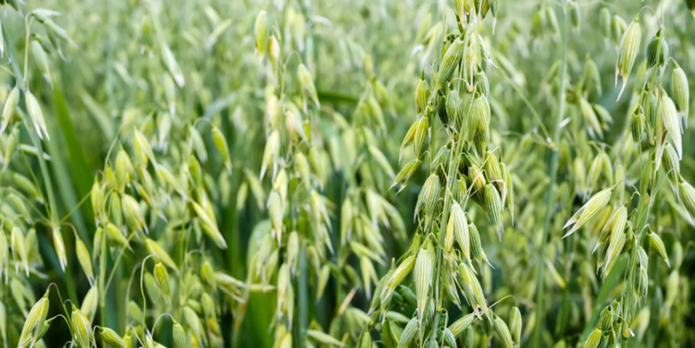
Photo Credits: EOS
Producers
- Ecoagri Serbia d.o.o.
Ekstravilan bb, 26340 Bela Crkva, Serbia
Phone: 013/851211, 013/851-041
Website: www.ecoagri.rs - LoginEKO doo
Tiski red 117, 23207 Aradac, Serbia
Website: www.logineko.com
General Information
- Total Area in Serbia: 250 ha
- Number of Varieties: 14
- Family: Poaceae
- Genus: Avena
- Species: Avena sativa L.
- Product Type: Cereals
Rotation
Oat is a good rotation crop and fits well after legumes or root crops. It improves soil texture and organic matter content. Avoid planting after other cereals to reduce the risk of pests and diseases.
Preceding Crops
- Peas, vetch, clover
- Potatoes or oil crops
- These crops improve nutrient availability and reduce weeds
Bed Preparation
- Plowing in autumn or early spring (depending on sowing)
- Shallow cultivation to create a firm, level seedbed
- Minimal tillage is possible with good soil structure
Fertilization
- 10–15 t/ha of composted manure before sowing
- Organic potassium and phosphorus based on soil analysis
- Avoid excess nitrogen to prevent lodging
Establishment
- Spring sowing: late February to mid-March
- Seeding rate: 180–220 kg/ha
- Row spacing: 12–15 cm
- Seeding depth: 3–4 cm
- Early sowing avoids heat stress during grain filling
Care
- Mechanical weed control (harrowing before and after emergence)
- High seeding density and rotation help suppress weeds
- Crown rust, smut, and leaf blotch may occur
- No chemical treatments allowed in organic; prevention through spacing and resistant varieties
Irrigation
Typically grown rainfed. Requires 350–450 mm water/season. Irrigation needed only during prolonged dry periods, especially around stem elongation and flowering.
Harvest
- Harvest: June or July, when grain moisture < 15%
- Combine harvesting is standard
- Timely harvest reduces shattering and lodging
- Grain dried to 12–13% for storage
- Straw collected for organic mulch or bedding
Rye

Photo Credits: Antropocene.it
Producers
- Data not available
General Information
- Total Area in Serbia: 827 ha
- Number of Varieties: 12
- Family: Poaceae
- Genus: Secale
- Species: Secale cereale L.
- Product Type: Cereals
Rotation
Rye fits well into organic rotations and is commonly grown after legumes, oil crops, or root crops. It suppresses weeds and improves soil structure. Avoid growing rye after other cereals to minimize disease risk.
Preceding Crops
- Clover, vetch, pea, potatoes, sunflower – leave clean, nutrient-rich soil
Bed Preparation
- Deep plowing in late summer or early autumn
- Followed by harrowing for a fine, level seedbed
- Minimal tillage possible in light soils due to rye’s strong roots
Fertilization
- Apply 10–15 t/ha of composted or green manure
- Phosphorus and potassium based on soil test
- Avoid high nitrogen to prevent lodging
Establishment
- Sowing time: late September to mid-October
- Seeding rate: 150–180 kg/ha
Spelt

Photo Credits: AgroElita
Producers
- PG Julijana Vlček; Prvoboračka 69, Pivnice, Bačka Palanka; +381 66 17 39 18
- PG Tružinski Sabolč; Glavna 55, Bačka Topola; +381 63 50 29 03; abc@tippnet.rs
General Information
- Total Area in Serbia: 221 ha
- Number of Varieties: 2
- Family: Poaceae
- Genus: Triticum
- Species: Triticum aestivum ssp. spelta
- Product Type: Cereals
Rotation
Spelt is well-suited to organic crop rotations and is typically grown after legumes, root crops, or oil crops. It improves soil health and competes well with weeds. Avoid sowing after cereals like wheat or barley to minimize disease pressure.
Preceding Crops
- Clover, peas, sunflower, potatoes – leave the field clean and enriched
Bed Preparation
- Autumn plowing followed by shallow cultivation
- Firm, level seedbed with good moisture retention
- Tolerates heavier, less fertile soils better than modern wheat
Fertilization
- 10–15 t/ha of well-rotted manure or compost before sowing
- Excess nitrogen should be avoided to reduce lodging risk
- Phosphorus and potassium amendments as per soil test results
Establishment
- Sowing period: late September to mid-October
- Seeding rate: 200–250 kg/ha due to large hulled seeds
- Row spacing: 12–15 cm; depth: 5–7 cm
- Cold-tolerant and hardy in winter conditions
Care
- Good weed suppression once established
- Mechanical cultivation recommended in early stages
- Low disease pressure; no need for synthetic fungicides or insecticides
- Seed health and proper hygiene important for disease prevention
Irrigation
Primarily rainfed due to drought tolerance. Irrigation may be used during dry spring periods to support grain filling. Water requirement: approximately 400 mm per cycle.
Harvest
- Harvest in late June or early July when grain moisture is below 15%
- Grain remains hulled post-harvest and requires dehulling
- Dried to 12–13% moisture before storage
- Straw used as bedding or mulch on organic farms
Wheat
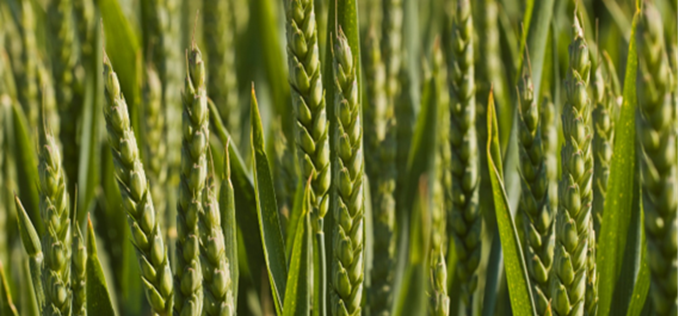
Photo Credits: Wikipedia – Common Wheat
Producers
- Ignjat Jurišić; Fruškogorska 39, 22213 Šuljam, Serbia; +381 64 642 8250; zlatnozrnosuljam@gmail.com
- LoginEKO doo.; Tiski red 117, 23207 Aradac, Serbia; logineko.com
General Information
- Total Area in Serbia: 1369 ha
- Number of Varieties: 271
- Family: Poaceae
- Genus: Triticum
- Species: Triticum aestivum L.
- Product Type: Cereals
Rotation
Wheat is a key part of organic rotations, often grown after legumes, oil crops, or early-harvested vegetables. It benefits from nitrogen fixation and helps maintain soil structure. Repeated cultivation on the same field should be avoided to reduce disease risk.
Preceding Crops
- Soybean, peas, vetch, clover, sunflower, potatoes – improve soil fertility and reduce weed and disease pressure.
Bed Preparation
- Plowing in late summer/early autumn, followed by shallow cultivation
- Create a firm, fine, level seedbed to ensure good emergence
Fertilization
- 10–15 t/ha of mature compost or organic manure before sowing
- Phosphorus and potassium added based on soil test results
- Avoid excessive nitrogen to prevent lodging
Establishment
- Autumn sowing: early to mid-October
- Seeding rate: 180–220 kg/ha
- Row spacing: 12–15 cm; sowing depth: 4–6 cm
- Early sowing promotes strong tillering and overwintering
Care
- Weed control through early mechanical hoeing and optimal crop density
- Disease management via resistant varieties and rotation
- No synthetic pesticides; focus on hygiene and balanced fertilization
Irrigation
Primarily rainfed. In dry conditions, irrigation during stem elongation and flowering can improve yield. Seasonal need is approx. 450–500 mm.
Harvest
- Harvest: late June to early July when moisture drops below 14%
- Combine harvesting standard; grain dried to 12–13% for storage
- Straw reused for bedding or returned to the field
Apple

Photo Credits: Lexington Medical Center Blog
Producers
- PG Dušanka Đukić; Carice Milice 7, Zrenjanin; +381 63 10 420 41
- PG Milenko Dolovac; Save Vukosavljeva 12, Futog; +381 62 510 048
- All Natural Foods d.o.o; Peta Industrijska 78, Nova Pazova; +381 22 32 55 28
- PG Milka Ilić; Mičurinova 32/12, Novi Sad; +381 64 896 22 95
General Information
- Total Area in Serbia: / ha
- Number of Varieties: 12
- Family: Rosaceae
- Genus: Malus
- Species: Malus domestica Borkh.
- Product Type: Fruit
Rotation
Apple is a perennial crop grown in orchard systems. Inter-row rotation with legumes, grasses, or herbs is used to enhance biodiversity, soil health, and pest control. Before orchard establishment, green manure crops are commonly used.
Preceding Crops
- Alfalfa, clover, mustard – improve soil structure and fertility
- Avoid previous orchard land with soil-borne pathogens or history of failure
Bed Preparation
- Performed 1 year in advance: deep plowing and subsoiling
- Add compost, lime, and correct pH or nutrient imbalances based on soil test
- Raised beds/ridges used in poorly drained soils
Fertilization
- 20–40 t/ha of composted manure or certified organic compost before planting
- Annual use of organic pellets, foliar bio-stimulants, and compost teas
- Mulch to improve organic matter and microbial life
Establishment
- Vegetative propagation; planting in dormancy (late autumn or early spring)
- Spacing: 4–5 m between rows; 1.5–3 m within rows (depends on rootstock)
- Training systems: spindle, bush, vertical cordon
Care
- Mechanical or mulch weed control
- Winter and summer pruning for structure, airflow, and fruit quality
- Eco-friendly pest control: copper, sulfur, neem, garlic, horsetail
- Use of pheromone traps and beneficial insects
- Biodynamic sprays may be applied
Irrigation
Drip irrigation is standard. Water needs range from 500–800 mm/season. Deficit irrigation before harvest can enhance quality. Mulching reduces water loss and cools soil.
Harvest
- Harvest season: August to October (depending on variety)
- Hand-harvested in multiple passes to prevent bruising
- Stored at 0–2°C in ventilated or cold storage conditions
- Certified organic apples are sorted, packed, and labeled accordingly
Aronia
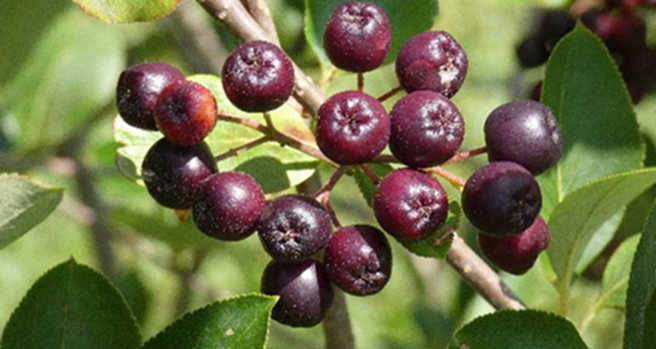
Photo Credits: Ohioline - Ohio State University
Producers
- PG Milenko Dolovac; Save Vukosavljeva 12, Futog; +381 62 510 048
- Aronija vita d.o.o.; Mala 87, Surduk, Stara Pazova; +381 64 55 108 31
General Information
- Total Area in Serbia: / ha
- Number of Varieties: 1
- Family: Rosaceae
- Genus: Aronia
- Species: Aronia melanocarpa (Michx.) Elliott
- Product Type: Fruit
Rotation
Before orchard establishment, green manure crops such as phacelia or clover are used to prepare the soil. Inter-row cultivation with grasses or legumes supports biodiversity and improves soil health.
Preceding Crops
- Alfalfa and annual legumes – enhance nitrogen and suppress weeds
- Avoid planting after other berry crops to prevent soil fatigue and disease
Bed Preparation
- Deep plowing and fine cultivation performed one season before planting
- Compost or rotted manure is mixed into the soil
- Raised beds may be used for better drainage on heavier soils
Fertilization
- 15–20 t/ha of composted manure before planting
- Annual applications of compost, liquid fertilizers, and foliar extracts
- Mulching with straw or wood chips improves moisture retention and soil health
Establishment
- Vegetative propagation from 2–3-year-old plants
- Planted in spring or autumn at 3–3.5 m between rows and 1.5–2 m within rows
- Compost is added to planting holes
- Root cuttings or tissue culture methods may also be used
Care
- Weed control through mechanical means or mulching
- Pruning in late winter encourages productive growth
- Naturally disease-resistant; pest control rarely needed
- Neem oil, garlic extract, or bird netting used when needed
- Support pollinators and beneficial insects through habitat creation
Irrigation
Drip irrigation is used during dry periods. Young plants need more water, while mature bushes tolerate short droughts. Annual water needs range from 400–600 mm.
Harvest
- Harvest takes place from late August to early September
- Manual picking or berry pickers are used
- Fruits harvested at full ripeness for maximum antioxidant value
- Berries are sorted, cleaned, and either stored or processed immediately
- Organic yields range from 6 to 10 t/ha
Blackberry

Photo Credits: Gardens Online – Blackberry Plant Info
Producers
/
General Information
- Total Area in Serbia: / ha
- Number of Varieties: 16
- Family: Rosaceae
- Genus: Rubus
- Species: Rubus fruticosus L.
- Product Type: Fruit
Rotation
Before planting, green manure or cover crops like phacelia or clover are used to improve soil. In mature orchards, inter-row sowing of grasses or legumes helps prevent erosion and boost biodiversity.
Preceding Crops
- Legumes, vegetables, or grain crops to build soil fertility
- Avoid replanting on former raspberry/blackberry land unless rested or disinfected
Bed Preparation
- Deep plowing and compost enrichment 6–12 months before planting
- Raised beds recommended in heavy soils for drainage
Fertilization
- Apply 20–30 t/ha of composted manure before planting
- Annual top-dressing with compost, mulch, or organic pellets
- Use foliar sprays (algae extracts, amino acids, biostimulants) for vigor and quality
- Potassium and calcium adjusted based on soil analysis
Establishment
- Propagation by rooted cuttings or tip layering
- Certified organic planting material used
- Spacing: 2.5–3 m between rows, 0.8–1.2 m within rows
- Install trellises or wire support systems at or before planting
Care
- Mechanical weed control or mulching
- Pruning after harvest to remove old canes
- Pest management with neem oil or traps (aphids, raspberry beetles)
- Disease control (botrytis, anthracnose) with airflow, mulching, copper sprays
- Encourage beneficial insects with hedgerows and biodiversity strips
Irrigation
Drip irrigation is critical during flowering and fruiting. First-year plants need regular watering. Seasonal needs range from 400–700 mm.
Harvest
- Begins late June or early July and continues in intervals every 2–3 days
- Hand-picked and cooled immediately after harvest
- Used fresh, frozen, or processed
- Organic yield: 10–15 t/ha
Sour Cherry
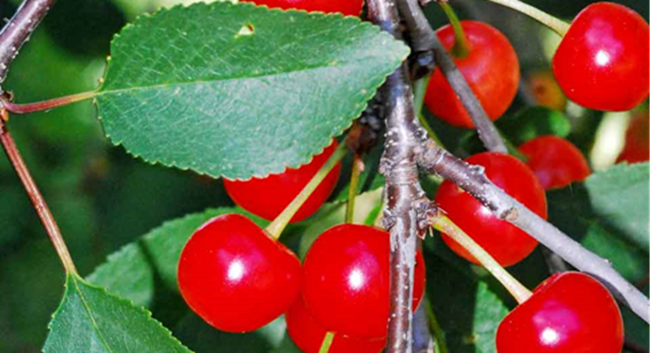
Photo Credits: Arbolapp – Prunus cerasus Info
Producers
PG Dušanka Đukić, Carice Milice 7, Zrenjanin; +381 63 10 420 41
General Information
- Total Area in Serbia: / ha
- Number of Varieties: 102
- Family: Rosaceae
- Genus: Prunus
- Species: Prunus cerasus L.
- Product Type: Fruit
Rotation
Before orchard establishment, cover crops such as mustard, vetch, or red clover improve soil structure and nitrogen content. In mature orchards, sowing grass-legume mixtures in alleys helps with erosion control and soil enrichment.
Preceding Crops
- Cereals, legumes, and vegetables with low pathogen risk
- Avoid other stone fruits to reduce soil-borne disease pressure
Bed Preparation
- 6–12 months before planting: deep plowing, subsoiling, leveling
- Compost and organic amendments are added based on soil analysis
- Ensure good drainage and wind protection for optimal tree health
Fertilization
- Pre-plant: 20–30 t/ha of well-rotted organic manure
- Annually: compost, mulch, and plant-based fertilizers
- Foliar sprays with seaweed, calcium, and micronutrients
Establishment
- Planting done in early spring or autumn
- Use grafted seedlings on Colt or Mahaleb rootstocks
- Spacing: 4–5 m between rows, 2.5–3 m in the row
- Tree training: central leader or spindle form
Care
- Weeds controlled with mulch, mowing, mechanical tools
- Pruning improves airflow and reduces disease risk
- Organic pest management: pheromone traps, botanical sprays, natural predators
- Common diseases: monilinia, leaf spot – managed with copper and sulfur inputs
- Pollination: supported by beehives and insectary plants
- Netting may be used to protect fruit from birds
Irrigation
Drip irrigation is crucial during flowering and fruit development. Total seasonal need is 400–700 mm. Overwatering must be avoided to prevent cracking and root disease.
Harvest
- Harvest from late June to early July
- Fruit is picked by hand or machine at full ripeness
- Rapid cooling ensures longer shelf life and better quality
- Yield: 8–15 t/ha in organic orchards depending on variety and management
Sweet Cherry

Photo Credits: Gardenia – Prunus avium 'Lapins'
Producers
No producers listed.
General Information
- Total Area in Serbia: / ha
- Number of Varieties: 31
- Family: Rosaceae
- Genus: Prunus
- Species: Prunus avium L.
- Product Type: Fruit
Rotation
Before orchard establishment, green manures such as vetch or mustard are used to improve soil fertility. In mature orchards, inter-row vegetation with legumes or grasses is practiced to support biodiversity, suppress weeds, and maintain soil health.
Preceding Crops
- Alfalfa, clover, cereals, or vegetables that leave the soil clean and enriched
- Avoid planting after other stone fruits or in orchards with known root rot issues
Bed Preparation
- Deep plowing and land leveling are performed 6 to 12 months before planting
- Compost and manure are incorporated to enhance soil fertility
- Soil pH and nutrient levels are adjusted based on analysis
Fertilization
- 20–30 t/ha of composted manure applied before planting
- Annual application of compost, mulch, and plant-based fertilizers as needed
- Foliar sprays with seaweed extract, humic and amino acids during flowering and fruiting
Establishment
- Certified grafted trees are planted in autumn or spring
- Rootstocks: Gisela 5/6 (semi-dwarf) or Colt (vigorous)
- Spacing: 4–5 m between rows and 2–3 m within rows
- Trellis or central leader systems used to manage canopy
Care
- Weeds managed mechanically or by mulching
- Summer and winter pruning improves form and productivity
- Copper- and sulfur-based sprays prevent fungal diseases
- Cherry fruit fly and aphids managed preventively with biodiversity strips and biocontrol
- Pollination supported by beehives and flowering strips
Irrigation
Drip irrigation maintains consistent moisture, especially during flowering, fruit swelling, and recovery. Overwatering is avoided to prevent fruit cracking and fungal issues.
Harvest
- Manual harvest in May or June depending on variety and region
- Fruits picked at full ripeness and handled delicately
- Immediate cooling ensures shelf life and quality
- Yields range from 8 to 12 t/ha under organic practices
Dogwood

Photo Credits: Plants of the World Online – Kew Science
Producers
No producers listed.
General Information
- Total Area in Serbia: / ha
- Number of Varieties: 1
- Family: Cornaceae
- Genus: Cornus
- Species: Cornus mas L.
- Product Type: Fruit
Rotation
Before planting, legume or grass cover crops are used to improve organic matter content. In established orchards, inter-row vegetation with grass or low legumes is maintained for biodiversity and soil health.
Preceding Crops
- Cereal or legume crops are ideal due to their soil-improving properties
- Avoid following fruit trees with similar rooting patterns or pest/disease risk
Bed Preparation
- Deep plowing and leveling done at least 6 months before planting
- Soil amendments: organic compost, manure, and dolomite if needed
- Final weed control and soil loosening just before planting
Fertilization
- Apply 20–25 t/ha of well-rotted manure before planting
- Annual compost or plant-based fertilization based on visual and soil indicators
- Foliar sprays (seaweed, nettle, amino acids) during flowering and fruiting
Establishment
- Grafted seedlings preferred for consistency; seeds or cuttings also used
- Planted in autumn or early spring
- Spacing: 4–5 m between rows, 3–4 m within rows
Care
- Weed management by mowing, mulching, or shallow tillage
- Light pruning to maintain shape and remove dead/diseased wood
- Minimal pest/disease pressure; copper/sulfur used preventively
- Self-fertile or partially self-fertile varieties ensure pollination
Irrigation
Though drought-tolerant, dogwood benefits from drip irrigation during flowering and fruit swelling. Avoid overwatering. Moisture stress can reduce both yield and quality.
Harvest
- Begins in August or early September as fruits soften and turn fully red
- Fruits are hand-picked or shaken onto nets
- Immediate post-harvest cooling improves storage and market quality
- Yields: 5–10 t/ha depending on care and plant age
Grapes
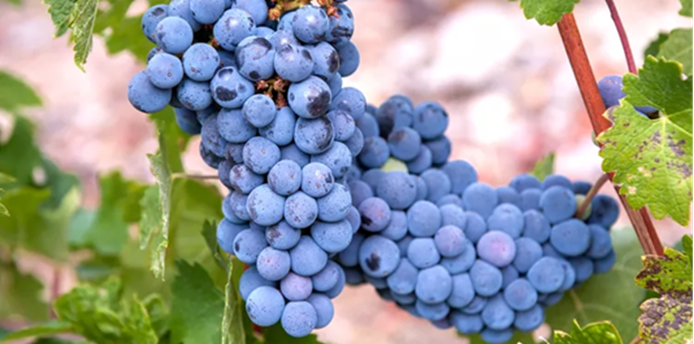
Photo Credits: The Spruce – Growing Common Grapes
Producers
PG Laslo Berenji; Železnička 8, Bački Vinogradi; +381 63 841 95 82
Imperator d.o.o.; Rumski drum 53a, Sremska Mitrovica; +381 60 754 7754
General Information
- Total Area in Serbia: / ha
- Number of Varieties: 720
- Family: Vitaceae
- Genus: Vitis
- Species: Vitis vinifera L.
- Product Type: Fruit
Rotation
Before vineyard establishment, legumes or green manure crops are used to improve soil fertility and structure. In organic vineyards, inter-row cover cropping and mulching are practiced to control weeds and enhance biodiversity.
Preceding Crops
- Best: cereals, clover, or low-residue crops
- Avoid: previous grapevine or deep-rooted perennial plantations
Bed Preparation
- Deep plowing and leveling at least 6 months before planting
- Apply organic compost or manure to enhance soil fertility
- Install trellis systems according to the planned training method
Fertilization
- Apply 20–30 t/ha of composted manure pre-planting
- Annually based on leaf analysis: compost, foliar feeds, green manure
- Legume cover crops used to improve nitrogen naturally
Establishment
- Plant grafted seedlings in autumn or spring
- Typical spacing: 2.5–3 m between rows, 1.2–1.5 m within row
- Use Guyot or pergola systems depending on grape variety
Care
- Mechanical/mulch weed control
- Winter pruning ensures ventilation and yield control
- Use copper/sulfur and natural products for disease prevention
- Pheromone traps and beneficial insects for pest control
- Canopy thinning and leaf removal support fruit health
Irrigation
Drip irrigation is applied during drought or fruit swelling stages. Avoid excessive watering to maintain sugar concentration, especially for wine grapes.
Harvest
- Harvest between late August and October, depending on variety
- Manual harvest for both table and wine grapes in organic systems
- Wine grapes harvested based on ripeness indicators (sugar/acid)
- Yields: 6–12 t/ha depending on grape type and vineyard management
Hazelnut
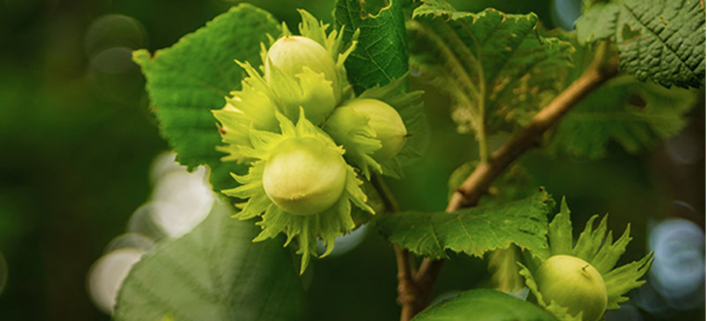
Photo Credits: Gardeners Path – How to Grow Hazelnut
Producers
–
General Information
- Total Area in Serbia: / ha
- Number of Varieties: 28
- Family: Betulaceae
- Genus: Corylus
- Species: Corylus avellana L.
- Product Type: Fruit
Rotation
Before planting, green manure crops like clover or phacelia improve soil fertility. Inter-row areas in young hazelnut plantations can be used for shallow-rooted vegetables or cover crops.
Preceding Crops
- Recommended: cereals, legumes, vegetables
- Avoid: previous orchards or nut trees to prevent soil-borne disease buildup
Bed Preparation
- Deep plowing and subsoiling at least 6 months before planting
- Incorporate organic compost, rock phosphate, or lime based on soil tests
- Level field and ensure proper drainage to prevent waterlogging
Fertilization
- 20–30 t/ha compost or well-decomposed manure before planting
- Annual topdressing with compost, mulch, and potassium sulfate as needed
- Foliar feeding with seaweed extracts or micronutrient solutions during key development stages
Establishment
- Plant in autumn or early spring using grafted or rooted hazelnut trees
- Spacing: 5–6 m between rows, 4–5 m within rows
- Training: bush form or central leader depending on machinery and orchard design
Care
- Weeds are managed through mulching, cultivation, or inter-row cover crops
- Annual pruning for shape, light, and disease prevention
- Monitor for pests (weevils, mites); apply biocontrol or plant-based treatments
- Ensure mixed varieties for better wind pollination
- Maintain soil cover to improve structure and biodiversity
Irrigation
Drip irrigation is used during dry periods, especially in flowering and nut-fill stages. Avoid overwatering to reduce disease risk and ensure nut quality.
Harvest
- Harvest from late August to early October as nuts naturally fall
- Collected manually or using mechanical sweepers/harvesters
- Nuts are dried to below 8% moisture for safe storage
- Organic yields: 1.5–3.5 t/ha depending on age and management
Peach
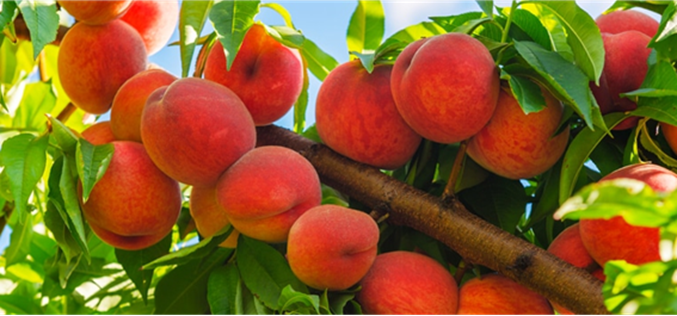
Photo Credits: Garden.eco – How to Grow a Peach Tree
Producers
PG Dušanka Đukić, Carice Milice 7, Zrenjanin; +381 63 10 420 41
General Information
- Total Area in Serbia: / ha
- Number of Varieties: 90
- Family: Rosaceae
- Genus: Prunus
- Species: Prunus persica L.
- Product Type: Fruit
Rotation
Before orchard establishment, cover crops such as vetch, buckwheat, or mustard are used to improve soil fertility and structure. In established orchards, inter-row planting of legumes or grasses supports soil biodiversity and reduces erosion.
Preceding Crops
- Recommended: cereals, legumes, vegetables
- Avoid: other stone fruit trees to minimize soil-borne pathogen risk
Bed Preparation
- Deep plowing and leveling at least 6 months before planting
- Incorporate compost or aged manure to enhance fertility
- Ensure adequate drainage and consider windbreaks in exposed locations
Fertilization
- 20–30 t/ha of decomposed organic manure or compost before planting
- Annual applications of compost, foliar treatments, and organic mineral inputs as needed
- Nutrient management based on soil and leaf tests
Establishment
- Grafted seedlings planted in autumn or early spring
- Spacing typically 5 x 3 m to 6 x 4 m depending on system
- Tree forms: open vase or modified central leader
Care
- Pruning to maintain shape and minimize disease pressure
- Weed control through mulching, mowing, or shallow cultivation
- Use of copper, sulfur, plant extracts, and traps for organic protection
- Monitoring for peach leaf curl, brown rot, aphids
- Pollination supported by habitat and safe spraying practices
Irrigation
Drip irrigation during flowering, fruit set, and dry periods. Reduce watering before harvest to enhance fruit quality. Avoid overwatering to reduce fruit cracking and disease.
Harvest
- Manual harvesting from June to August, depending on variety
- Picked at full ripeness for fresh use; earlier for processing
- Immediate cooling and gentle handling preserve quality
- Organic yields: 10–20 t/ha depending on conditions
Pear
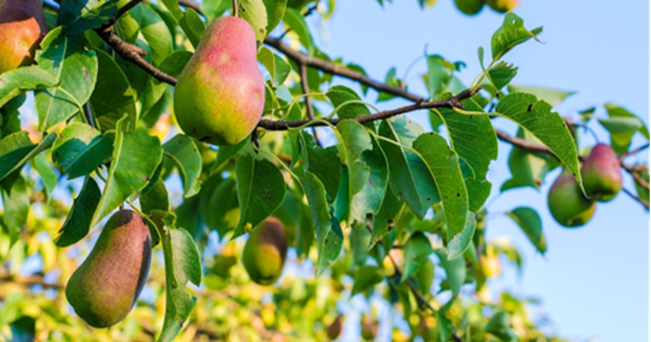
Photo Credits: Better Homes & Gardens – Best Types of Pear Trees
Producers
PG Milenko Dolovac, Save Vukosavljeva 12, Futog; +381 62 510 048
General Information
- Total Area in Serbia: / ha
- Number of Varieties: 101
- Family: Rosaceae
- Genus: Pyrus
- Species: Pyrus communis L.
- Product Type: Fruit
Rotation
Before planting, green manure crops such as clover or phacelia are used to enrich soil and suppress weeds. Living mulches or cover crops may be maintained between rows to support soil health and beneficial organisms.
Preceding Crops
- Recommended: cereals, legumes, vegetables
- Avoid: apples or other pome fruits due to disease risks
Bed Preparation
- Deep plowing and subsoiling to improve drainage and root penetration
- Compost and organic soil amendments incorporated based on analysis
- Additional compost or biochar may be used in planting holes
Fertilization
- 20–30 t/ha of well-rotted manure before planting
- Annual inputs of compost, organic phosphorus and potassium, and foliar feeds
- Adjust fertilization according to soil and leaf test results
Establishment
- Grafted seedlings planted in autumn or early spring
- Spacing: 4–5 m between rows, 2–3 m within rows
- Training systems: central leader or modified spindle
Care
- Annual pruning in late winter for form and yield regulation
- Weed control with mulch, mowing, or mechanical means
- Scab and fire blight managed with copper compounds and resistant varieties
- Pests like codling moth, pear psylla, and aphids managed with traps and biocontrol
- Pollination enhanced by compatible varieties and pollinator-friendly environment
Irrigation
Irrigation during flowering, fruit development, and dry periods using drip systems for efficiency. Moisture levels are monitored to prevent drought or excessive humidity.
Harvest
- Harvest from August to October, depending on variety
- Picked before full ripeness for storage; fully ripe for fresh use
- Manual harvest in multiple passes
- Organic yields: 15–25 t/ha depending on variety and management
Plum
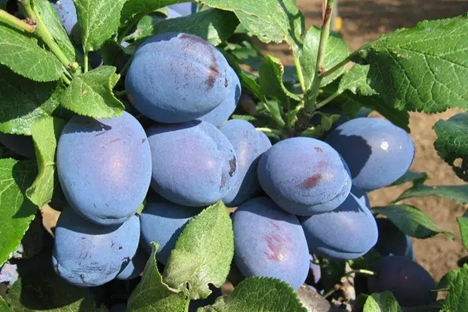
Photo Credits: Sadnice šljive 'ČAČANSKA LEPOTICA' | Silja Plant
Producers
No data available
General Information
- Total Area in Serbia: / ha
- Number of Varieties: 83
- Family: Rosaceae
- Genus: Prunus
- Species: Prunus domestica L.
- Product Type: Fruit
Rotation
Before orchard establishment, green manure crops are used to improve soil fertility and reduce weed pressure. In young orchards, inter-row space can be temporarily used for vegetables or legumes.
Preceding Crops
- Recommended: cereals, legumes, vegetables
- Avoid: other stone fruits due to disease risks
Bed Preparation
- Deep plowing and organic matter incorporation 6–12 months prior to planting
- Leveling and drainage planning are essential to prevent root diseases
- Planting rows and irrigation layout designed in this phase
Fertilization
- Apply 20–40 t/ha of well-decomposed manure before planting
- Use compost, wood ash, and foliar treatments annually
- Support fertility through green manure and leguminous cover crops
Establishment
- Grafted seedlings planted in autumn or early spring
- Spacing: 5–6 m between rows, 3–4 m within rows
- Training systems: vase or central leader for air and light optimization
Care
- Annual pruning to maintain structure and reduce disease risk
- Weed management via mulch, mowing, or mechanical cultivation
- Manage plum pox virus, brown rot with copper sprays and resistant varieties
- Use biological controls and traps for aphids and plum moth
- Pollination supported through compatible varieties and wild pollinators
Irrigation
Drip irrigation during dry periods, especially flowering and fruit swelling stages. Avoid irrigation close to harvest to prevent cracking. Monitor soil moisture to prevent stress.
Harvest
- Harvest period: July to September, depending on variety
- Manual harvest in several passes to ensure ripeness
- Fully ripe fruits harvested for drying and processing
- Organic yields range from 15–30 t/ha depending on orchard age and care
Raspberry
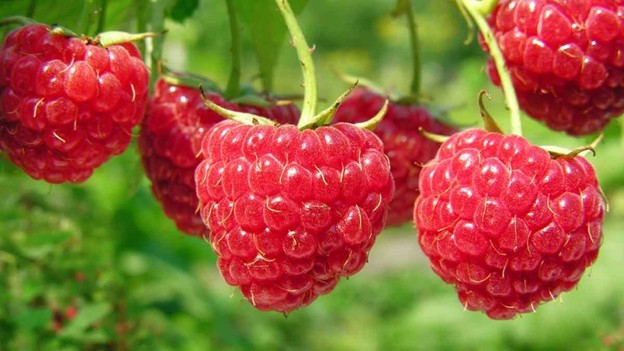
Photo Credits: What's in Season? Raspberries - Canadian Food Focus
Producers
No data available
General Information
- Total Area in Serbia: / ha
- Number of Varieties: 44
- Family: Rosaceae
- Genus: Rubus
- Species: Rubus idaeus L.
- Product Type: Fruit
Rotation
Raspberry is a perennial but benefits from being replanted after 8–10 years in the same location. Prior to planting, rotation with legumes, cereals, or green manure crops helps improve soil structure and fertility. In organic systems, inter-row grass or legume cover crops are maintained for erosion control and biodiversity.
Preceding Crops
- Recommended: legumes, cereals, root vegetables
- Avoid: solanaceous crops or other berry species
Bed Preparation
- Deep plowing and compost incorporation 6–12 months before planting
- Use raised beds or ridges in poorly drained soils
- Field must be weed-free and well-leveled
Fertilization
- Apply 25–35 t/ha of well-rotted manure or compost before planting
- Annual compost and plant-based foliar fertilization (e.g., seaweed, nettle)
- Use nitrogen-fixing cover crops in inter-rows
Establishment
- Certified organic planting material: bare-root or container-grown
- Spacing: 2.5–3 m between rows, 0.3–0.5 m within rows
- Trellis systems: V-trellis or vertical wire
Care
- Weed control via mulch, mowing, or mechanical cultivation
- Prune after harvest to remove old canes; thin new canes in spring
- Control cane blight and botrytis with airflow, resistant varieties, and copper-based sprays
- Use biological control for aphids and raspberry beetle
- Enhance pollination with wildflowers and bee habitats
Irrigation
Use drip irrigation to maintain soil moisture during flowering and fruiting. Avoid overwatering to prevent disease. Mulch helps with water retention and temperature stabilization.
Harvest
- Harvest begins in June and can extend to August
- Manual picking every 2–3 days as fruits ripen
- Immediate cooling and gentle handling required
- Organic yields: 5–10 t/ha depending on density and system
Rosehip
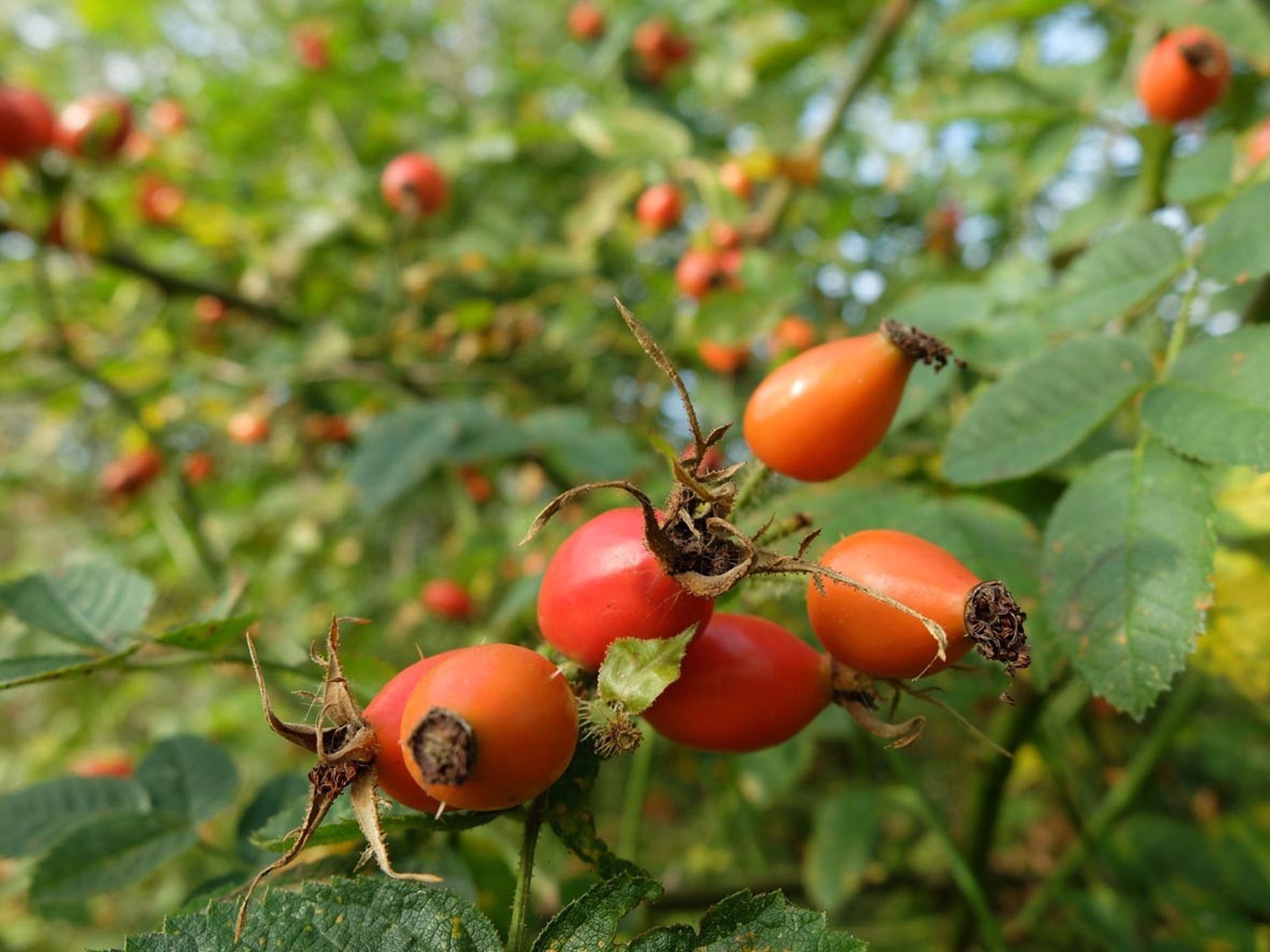
Photo Credits: Love and Loss – Rose Hips
Producers
PG Fekete Karolj; Srpska 73; Novi Kneževac; +381 63 81 86 386; zadenpak@gmail.com
General Information
- Total Area in Serbia: / ha
- Number of Varieties: 16
- Family: Rosaceae
- Genus: Rosa
- Species: Rosa canina L.
- Product Type: Fruit
Rotation
Prior to planting, land is improved with green manure crops such as vetch or buckwheat. Between rows, cover crops or native grasses can be maintained to improve soil and support beneficial insects.
Preceding Crops
- Recommended: cereals, legumes, vegetables
- Avoid: rosaceous species (e.g. apple, pear, plum)
Bed Preparation
- Deep plowing and compost incorporation 6–12 months before planting
- Leveling and wind protection considered in open areas
- Furrows or planting beds prepared based on terrain
Fertilization
- Apply 20–30 t/ha of organic compost before planting
- Annual fertilization includes compost, wood ash, and foliar sprays with nettle or comfrey extract
- Inter-row vegetation helps maintain fertility and reduce erosion
Establishment
- Planted in late autumn or early spring from seedlings or grafted plants
- Spacing: 3–4 m between rows and 1.5–2 m in the row
- Young plants are protected from weed competition and drying
Care
- Weed control through mulch, mowing, and mechanical methods
- Pruning increases over years to shape and enhance fruiting
- Pests like aphids are managed with natural predators and plant extracts
- Disease prevention includes airflow management and copper-based sprays
- Pollination enhanced by floral biodiversity and insect activity
Irrigation
Irrigation is used during dry periods, especially during flowering and fruit set. Drip irrigation and mulching help conserve moisture and limit disease risk.
Harvest
- Harvested manually in late summer or autumn when fruits are fully red and firm
- Gloves or tools used to avoid thorns
- Fruits are either dried or processed fresh
- Yields range from 3 to 7 t/ha in organic systems
Sambucus

Photo Credits: Wikipedia – Sambucus
Producers
PG Laslo Berenji; Železnička 8 Bački Vinogradi; +381 63 841 95 82; berenjil@gmail.com
General Information
- Total Area in Serbia: / ha
- Number of Varieties: 2
- Family: Adoxaceae
- Genus: Sambucus
- Species: Sambucus nigra L.
- Product Type: Fruit
Rotation
Elderberry is a perennial shrub and remains productive in one location for 15–20 years. Before planting, green manure crops like clover, phacelia, or buckwheat are used to enrich the soil. Inter-row vegetation with grass-legume mixtures supports biodiversity and reduces erosion.
Preceding Crops
- Recommended: cereals, legumes, vegetables
- Avoid: other perennial shrubs (to avoid soil fatigue and disease transfer)
Bed Preparation
- Deep plowing and incorporation of 25–30 t/ha of well-rotted manure at least six months before planting
- Leveling and ensuring good drainage (elderberry is sensitive to waterlogging)
- Marking rows for planting and irrigation setup
Fertilization
- Compost applied at planting; annual applications follow
- Organic nitrogen from alfalfa meal, nettle extract, or compost tea in spring and early summer
- Phosphorus and potassium adjusted based on soil/leaf testing, using rock phosphate and wood ash
Establishment
- Planted from seedlings or rooted cuttings in autumn or early spring
- Spacing: 4 x 2.5 m or 5 x 3 m
- Mulching immediately after planting
Care
- Annual pruning in late winter for renewal and shaping
- Weed control through straw mulch, cultivation, or inter-row vegetation
- Disease control with sulfur or copper if needed
- Pest control with physical barriers, traps, and promoting beneficial insects
- Pollination supported by planting flowering hedgerows and insect hotels
Irrigation
Regular irrigation is needed, especially during establishment, flowering, and fruit development. Drip irrigation and mulching are used to conserve water and reduce disease risk.
Harvest
- Manual harvest from August to September
- Fruits are cut in clusters and processed immediately
- Used fresh or dried for tea and medicinal products
- Organic yield: 7 to 12 t/ha depending on age and care
Strawberry

Photo Credits: BBC Gardeners’ World Magazine
Producers
Zdravo Dobro d.o.o.; Carice Milice 7 Zrenjanin; +381 63 104 20 41
General Information
- Total Area in Serbia: / ha
- Number of Varieties: 88
- Family: Rosaceae
- Genus: Fragaria
- Species: Fragaria × ananassa Duchesne ex Weston
- Product Type: Fruit
Rotation
Strawberries are cultivated in short rotations of 2–3 years and then moved to new fields. Effective rotations include legumes, cereals, or green manure crops like mustard or buckwheat. Avoid planting after solanaceous crops or strawberries to reduce the risk of soil-borne diseases.
Preceding Crops
- Recommended: legumes, cereals, green manures
- Avoid: crops susceptible to Verticillium wilt or root nematodes
Bed Preparation
- Deep plowing and application of 20–30 t/ha of compost or well-rotted manure
- Raised beds improve drainage and reduce disease risk
- Drip irrigation lines and straw or biodegradable film mulch are installed before planting
Fertilization
- Pre-plant fertilization with compost, rock phosphate, and potassium-rich amendments
- Top-dressing includes compost tea or nettle extract during flowering and fruiting
- Soil fertility is supported by inter-row legumes or post-harvest compost applications
Establishment
- Planted as bare-root or plug plants in late summer or early spring
- Spacing: 30–40 cm between plants and 70–100 cm between rows
- Systems: matted row or plasticulture using biodegradable mulch
Care
- Weeds are controlled by mulching, cultivation, and mowing
- Old leaves removed post-harvest to reduce disease risk
- Grey mold and powdery mildew managed with copper and sulfur sprays
- Pests like aphids, thrips, and slugs managed with netting, biocontrols, and diatomaceous earth
- Pollination enhanced by preserving flowering margins and avoiding insecticides during bloom
Irrigation
Drip irrigation is used to maintain consistent soil moisture and prevent diseases. Watering is critical during flowering, establishment, and fruit ripening to avoid fruit cracking and uneven maturity.
Harvest
- Begins 60–90 days after planting, depending on the variety
- Hand-harvested every 2–3 days for best quality
- Fruits are immediately cooled to preserve freshness
- Typical organic yields range from 8 to 15 t/ha
Walnut

Photo Credits: Prairie Gardens
Producers
–
General Information
- Total Area in Serbia: / ha
- Number of Varieties: 31
- Family: Juglandaceae
- Genus: Juglans
- Species: Juglans regia L.
- Product Type: Fruit
Rotation
Walnut is a long-living perennial species, productive for decades. Before orchard establishment, soil is improved using green manure crops such as vetch, clover, or mustard. Crop rotation is only relevant in the pre-orchard phase or when used in intercropping systems.
Preceding Crops
- Recommended: cereals, legumes, vegetables
- Avoid: other nut trees or species prone to root diseases
Bed Preparation
- Deep plowing and soil leveling at least 6–12 months before planting
- Apply 30–40 t/ha of decomposed manure or compost
- Ensure proper drainage, especially in compact soils
Fertilization
- Base fertilization includes compost, rock phosphate, and organic potassium prior to planting
- Annually: compost, green manure mulch, and foliar bio-stimulants
- Inter-row cover crops support nitrogen input and organic matter build-up
Establishment
- Planted as grafted saplings in late autumn or early spring
- Recommended spacing: 8 x 8 m or more depending on soil and variety
- Staking and protection from wind/wildlife required for young trees
Care
- Light pruning early; more structural pruning as canopy develops
- Weeds controlled through mulching, mowing, and shallow tillage
- Pests: walnut husk fly and codling moth controlled with traps and beneficial insects
- Diseases: anthracnose and walnut blight managed with copper and resistant varieties
- Pollination is wind-driven; planting pollinator varieties is beneficial
Irrigation
Irrigation is crucial in dry regions and during the first 5–7 years. Use drip or micro-sprinkler systems for efficient deep watering. Avoid overwatering to reduce root rot and nutrient loss.
Harvest
- Harvest occurs when husks split and nuts fall, typically September–October
- Methods: shaking or manual collection from the ground
- Nuts are cleaned, dried to 8–10% moisture, and stored in cool, dry conditions
- Organic yields: 2–4 t/ha of dry nuts depending on tree age and management
Wild Blackberry

Photo Credits: Livestrong
Producers
–
General Information
- Total Area in Serbia: / ha
- Number of Varieties: –
- Family: Rosaceae
- Genus: Rubus
- Species: Rubus fruticosus L.
- Product Type: Fruit
Rotation
Wild blackberry is a perennial shrub used in hedgerows or managed plantations. Prior to establishment, rotation with legumes or green manure crops enhances soil fertility. Once planted, blackberries can remain productive for 10–15 years and are not rotated.
Preceding Crops
- Recommended: legumes, cereals, vegetables
- Avoid: other berry crops to reduce disease risk
Bed Preparation
- Deep soil loosening and addition of 25–30 t/ha compost or aged manure
- Raised beds used in poorly drained soils
- Trellis system and weed control planned before planting
Fertilization
- Organic fertilization using compost, mulch, and foliar plant extracts
- Compost or aged manure applied annually around plant base
- Green manure crops in inter-rows contribute to fertility
Establishment
- Planted using rooted cuttings or container plants in early spring or autumn
- Typical spacing: 2.5–3 m between rows, 0.5–1 m between plants
- Trellising essential for cane support and ventilation
Care
- Annual pruning removes old canes and thins new growth
- Mulching, mowing, and cover crops manage weeds
- Common diseases (anthracnose, rust) managed with pruning and copper products
- Pests (mites, aphids, beetles) managed biologically
- Pollination supported with wildflower strips and spray-free bloom periods
Irrigation
- Drip irrigation used to maintain even moisture
- Mulching helps retain soil moisture and moderate temperature
- Excessive irrigation avoided to reduce fungal disease
Harvest
- Harvest from June to September depending on variety and site
- Manual picking every 2–3 days for ripe berries
- Fruits are delicate and must be cooled immediately
- Organic yields: 5–10 t/ha depending on density and care
Wild Blueberry

Photo Credits: VanDrunen Farms
Producers
–
General Information
- Total Area in Serbia: / ha
- Number of Varieties: –
- Family: Ericaceae
- Genus: Vaccinium
- Species: Vaccinium myrtillus L.
- Product Type: Fruit
Rotation
Wild blueberry is a perennial typically found in natural or semi-managed acidic meadows or forest clearings. While conventional crop rotation isn't applied, agroforestry practices or understory management can enhance long-term productivity. Controlled burning is used in some regions but not in European organic systems.
Preceding Crops
- Recommended: native grasslands, forest clearings with suitable pH
- Avoid: sites with herbicide residues or unsuitable pH
Bed Preparation
- Soil must be acidic (pH 4.0–5.0), sandy, and organic-rich
- Pine mulch or acidic peat may be applied
- Minimal soil disturbance to preserve mycorrhizal networks
Fertilization
- Minimal inputs, adapted to natural conditions
- Occasional use of forest litter, conifer compost, or biochar
- Avoid manure and high-nitrogen fertilizers
Establishment
- Propagation via rhizome division or wild seedlings in spring/autumn
- Spacing: 20–30 cm between plants, 50–70 cm between rows
- In wild systems, natural regeneration is supported by protection
Care
- Weed suppression using conifer needles or ground cover
- Trimming may be used to stimulate growth in managed plots
- Pests (birds, small mammals) controlled by physical barriers
- Fungal disease avoided with airflow and low handling
Irrigation
- Not required in natural stands
- Drip irrigation may be applied during drought in cultivated systems
- Even moisture levels maintained—avoid drought or flooding
Harvest
- Harvested by hand using berry combs or manual picking
- Season: July–August
- Fruits must be cooled quickly due to sensitivity
- Typical wild yield: 300–1,000 kg/ha depending on site and year
- Sustainable harvest includes leaving berries for wildlife
Wild Strawberry
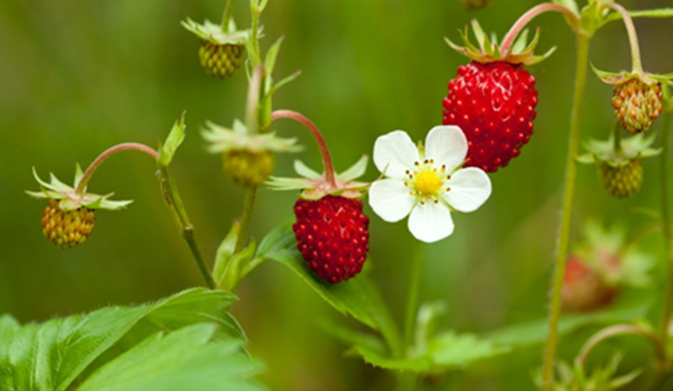
Photo Credits: Gardening Know How
Producers
–
General Information
- Total Area in Serbia: / ha
- Number of Varieties: –
- Family: Rosaceae
- Genus: Fragaria
- Species: Fragaria vesca L.
- Product Type: Fruit
Rotation
Wild strawberry is a perennial plant used in natural habitats or low-input systems. It remains productive for 3–4 years and is then rotated with legumes or cereals. In agroforestry and permaculture, it serves as permanent ground cover.
Preceding Crops
- Recommended: legumes, green manures, cereals
- Avoid: solanaceous crops and other berries
Bed Preparation
- Light tillage and compost or forest humus incorporation
- Raised beds with good drainage prevent root rot
- Preferred pH: 5.5–6.5
Fertilization
- Pre-plant compost or aged manure
- Low-dose foliar feed (e.g., nettle tea, seaweed extract) during flowering
- Natural mulches and compost top-dressings support fertility
Establishment
- Propagation by seed, runners, or transplanting wild plants
- Planting in spring or autumn, 20–30 cm between plants, 40–60 cm between rows
- Mulching with straw or leaf litter post-planting
Care
- Manual weed control and mulching
- Old leaf removal reduces disease
- Slugs and aphids managed with predators, barriers, or diatomaceous earth
- Powdery mildew managed with sulfur-based sprays and airflow
Irrigation
- Regular watering during flowering and fruiting
- Drip irrigation preferred to avoid wetting foliage
- Moisture must be steady to prevent cracking and fungal issues
Harvest
- Manual harvest every 2–3 days from May to July
- Fruits are delicate and need fast cooling
- Yields: 1–2 t/ha depending on care
- Leaves can also be harvested for tea before flowering
Alfalfa

Photo Credits: Britannica
Producers
- PG Bojana Maljković, Kralja Petra I 20, Banatsko Karađorđevo, Žitište, +381 65 83 52 911, maljkovicrade@gmail.com
- PG Laslo Berenji, Železnička 8, Bački Vinogradi, +381 63 841 95 82
General Information
- Total Area in Serbia: / ha
- Number of Varieties: 27
- Family: Fabaceae
- Genus: Medicago
- Species: Medicago sativa L.
- Product Type: Industrial crop
Rotation
Alfalfa is a perennial forage crop typically rotated with cereals or root crops. It remains on the same plot for 3–5 years depending on weed pressure and stand vigor, while enhancing soil fertility via nitrogen fixation and biomass.
Preceding Crops
- Recommended: cereals, maize, early-harvested vegetables
- Avoid: other legumes due to pest/disease carryover
Bed Preparation
- Deep plowing and fine levelling to ensure germination
- False seedbed method used for weed suppression
- Soil pH should be above 6.0 with good drainage
Fertilization
- Pre-sowing: compost and rock phosphate
- Rhizobium meliloti inoculation required if not previously cultivated
- Post-establishment fertilization is minimal if soil health is maintained
Establishment
- Sowing done in early spring or late summer
- Seed rate: 18–25 kg/ha in pure stand
- Row spacing: 12–15 cm; sowing depth: 1–2 cm
Care
- Weed control in first year via mowing or light cultivation
- No pesticide use; dense stand suppresses weeds
- Pests (aphids, weevils) managed biologically
- Diseases (root rot, anthracnose) avoided via rotation and drainage
Irrigation
- Generally not irrigated; may benefit from supplemental watering in drought
- Excess moisture avoided to prevent root disease
Harvest
- First cut at early bloom for best quality
- 3–5 cuts annually depending on region and plant age
- Drying in field for hay; silage if conditions are humid
- Organic yields: 8–12 t/ha of dry matter annually
Hemp (seeds)

Photo Credits: Naturfaserverband
Producers
LOGIN EKO d.o.o.; Đevđelijska 9, 11050 Beograd, Srbija; +38169 685 148
General Information
- Total Area in Serbia: / ha
- Number of Varieties: 6
- Family: Cannabaceae
- Genus: Cannabis
- Species: Cannabis sativa L.
- Product Type: Industrial crop
Rotation
Hemp fits well into organic crop rotation due to its weed-suppressing ability and fast growth. It is typically rotated after cereals or legumes and before crops sensitive to weeds. Hemp should not be grown continuously on the same land to prevent pest buildup.
Preceding Crops
- Recommended: legumes, cereals
- Avoid: crops that leave compacted soil or severe weed infestation
Bed Preparation
- Soil plowed and harrowed for fine, firm seedbed
- Ensure good seed-to-soil contact and uniform germination
- No herbicide or chemical seed residue allowed
Fertilization
- 20–30 t/ha of compost or aged manure before sowing
- Optional additions: rock phosphate, potassium sulfate based on soil test
- Green manure crops from prior seasons supply nitrogen
Establishment
- Sowing from mid-April to early May when soil reaches 10–12°C
- Sowing rate: 50–70 kg/ha for seed production
- Row spacing: 15–20 cm, seeding depth: 3–4 cm
Care
- Weed control mainly via rapid canopy closure
- Mechanical weeding possible in early growth stages
- Pests and diseases are rare, managed preventively
- No pesticide or fungicide use in organic systems
Irrigation
- Generally not required in temperate climates
- Supplemental irrigation helps during flowering and seed development if drought occurs
Harvest
- Harvest when 60–70% of seeds are mature and hard
- Cutting and drying may be needed before threshing
- Seed moisture for storage: below 9%
- Organic seed yields: 800–1,500 kg/ha
Mustard Plant

Photo Credits: Sow Right Seeds
Producers
PG Tružinski Sabolč; Glavna 55 Bačka Topola; +381 63 50 29 03
General Information
- Total Area in Serbia: / ha
- Number of Varieties: 140
- Family: Brassicaceae
- Genus: Sinapis or Brassica
- Species: Sinapis alba L. or Brassica juncea L.
- Product Type: Industrial crop
Rotation
Mustard fits well into rotation with cereals and legumes, acting as a biofumigant and weed suppressant. Avoid growing mustard after other brassicas to reduce pest and disease pressure.
Preceding Crops
- Recommended: cereals, legumes, green manures
- Avoid: other brassicas or crops prone to clubroot and flea beetles
Bed Preparation
- Finely tilled, levelled seedbed with good drainage
- Stale seedbed technique can help control early weeds
Fertilization
- 10–20 t/ha of compost or aged manure before sowing
- Optional phosphorus/potassium based on soil tests
- Minimal nitrogen to avoid lodging
Establishment
- Sown in early spring or late summer
- 8–12 kg/ha (Sinapis alba), 6–10 kg/ha (Brassica juncea)
- Row spacing: 15–25 cm; sowing depth: 1.5–2 cm
Care
- Mechanical weeding during early growth
- Fast growth smothers weeds naturally
- Pests (aphids, flea beetles) managed with nets, neem, trap crops
- Diseases (mildew, rust) reduced by rotation and resistant varieties
Irrigation
- Generally rainfed
- Supplemental irrigation may help during flowering and seed fill
- Avoid overwatering before harvest to reduce seed shattering
Harvest
- Harvest when pods yellow and seeds harden
- Cut, windrow, then thresh after drying
- Seeds stored below 9% moisture
- Yields: 800–1,500 kg/ha organically
Chanterelle
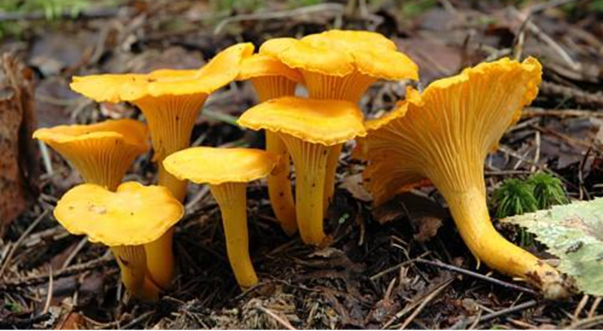
Photo Credits: Arktiset Aromit ry
Producers
–
General Information
- Total Area in Serbia: / ha
- Number of Varieties: –
- Family: Cantharellaceae
- Genus: Cantharellus
- Species: Cantharellus cibarius Fr.
- Product Type: Mushroom
Rotation
Chanterelle is a wild ectomycorrhizal fungus that forms symbiosis with tree roots (beech, oak, pine, spruce). It is not part of crop rotation but can be supported in agroforestry through forest and soil preservation.
Preceding Crops
- Not applicable in natural environments
- In managed environments: forest understory or perennial undisturbed cover
Bed Preparation
- No conventional bed preparation; grows in natural forest soils with high humus
- In inoculated systems, seedlings are pre-inoculated with mycelium
- Minimal disturbance, shade, and leaf litter preservation are crucial
Fertilization
- No fertilizers applied
- Relies on forest organic matter and natural nutrient cycles
- Animal-based and synthetic fertilizers are avoided
Establishment
- No direct sowing; cultivation not yet commercially viable
- Experimental inoculation of tree roots in controlled forest nurseries
- Full establishment may take several years before mushrooms appear
Care
- Habitat preservation is key
- Soil compaction, overharvesting, and grazing are avoided
- Mulching with forest litter helps maintain fungal health
Irrigation
- Not irrigated in the wild
- Moist forest microclimate supports natural fruiting
- Artificial irrigation is not used
Harvest
- Harvested by hand from July to October
- Fruits gently twisted or cut to avoid damaging mycelium
- Yields vary: 20–200 kg/ha
- Sustainable harvest includes leaving young mushrooms behind
Mushrooms

Photo Credits: Dobro Jutro
Producers
–
General Information
- Total Area in Serbia: / ha
- Number of Varieties: –
- Family: Agaricaceae
- Genus: Agaricus
- Species: Agaricus bisporus J.E. Lange
- Product Type: Mushroom
Rotation
Mushrooms are cultivated in a closed-loop system. Organic producers rotate trays or rooms rather than fields. Spent substrate is reused as compost in crop rotations.
Preceding Crops
- Not applicable in controlled indoor cultivation
- Spent substrate used for vegetables or cereals after mushroom production
Bed Preparation
- Pasteurized compost made from straw, poultry manure, and gypsum is used
- Compost placed in trays or shelves in climate-controlled rooms
- Peat or coir casing layer added after colonization
Fertilization
- Integrated into compost before spawning
- Organic inputs include plant-based compost, gypsum, rock phosphate
- No synthetic or animal-based fertilizers allowed
Establishment
- Spawn (mycelium) mixed into compost at 0.5–1.2% of wet weight
- Colonization takes 14–18 days at 22–25°C
Care
- Temperature, humidity, and CO₂ controlled via ventilation and misting
- Fruiting sensitive to airflow and light
- No chemical pest control used in organic systems
Irrigation
- Fine mist systems maintain 85–95% humidity
- Water must meet organic quality standards
- Overwatering avoided to reduce diseases
Harvest
- First flush ready 17–21 days after casing layer
- Harvested dai
Oyster Mushrooms

Photo Credits: GroCycle
Producers
–
General Information
- Total Area in Serbia: / ha
- Number of Varieties: –
- Family: Pleurotaceae
- Genus: Pleurotus
- Species: Pleurotus ostreatus
- Product Type: Mushroom
Rotation
Oyster mushrooms are cultivated in controlled indoor or semi-controlled environments, not in fields. Rotation applies to substrate use, which is composted or used as soil amendment in crop rotations for vegetables or cereals.
Preceding Crops
- Not applicable for direct cultivation
- Spent substrate enriches soil for future crops
Bed Preparation
- Substrate includes pasteurized straw, sawdust, corn stalks, or coffee grounds
- Moistened and packed into bags or trays
- Sterilization or pasteurization is critical
Fertilization
- Nutrient input is part of substrate, including wheat bran or organic supplements
- No synthetic fertilizers allowed
Establishment
- Spawn added at 2–5% of substrate weight
- Colonization at 20–28°C for 10–14 days
Care
- Maintain temperature (18–24°C), humidity (85–95%), light, and airflow
- Sanitation and biological control used for pest management
- No synthetic fungicides or pesticides
Irrigation
- Regular misting to maintain humidity
- Water quality must meet organic standards
Harvest
- Harvested 5–10 days after pinning
- Picked by hand to encourage further flushes
- Yields: 15–25 kg per 100 kg of dry substrate
Beans

Photo Credits: The Spruce
Producers
–
General Information
- Total Area in Serbia: / ha
- Number of Varieties: 25
- Family: Fabaceae
- Genus: Phaseolus
- Species: Phaseolus vulgaris L.
- Product Type: Protein sources
Rotation
Beans are well-suited for organic rotations due to their nitrogen-fixing ability. They are rotated with cereals, root crops, and vegetables to reduce pest and disease buildup. Continuous bean cropping should be avoided to minimize soil pathogen risks.
Preceding Crops
- Preferred: cereals, early maturing vegetables
- Avoid: other legumes or pest-prone crops
Bed Preparation
- Soil is plowed and harrowed to a fine tilth
- Well-drained, weed-free beds support strong establishment
- Organic mulch used post-emergence
Fertilization
- Green manure or composted manure provides nutrients
- Rhizobium inoculation enhances nitrogen fixation
- Soil test determines phosphorus and potassium needs
Establishment
- Sowing in late spring when soil temp exceeds 15°C
- Seed depth: 3–5 cm; spacing: 30–50 cm rows, 5–10 cm plants
- Seed rate varies with variety
Care
- Manual or mechanical weeding critical pre-canopy closure
- Climbing varieties may need support
- Organic biopesticides used for aphids and beetles
- Crop hygiene and rotation reduce disease pressure
Irrigation
- Moderate, consistent moisture especially during flowering and pod fill
- Drip or overhead irrigation systems used
- Foliage wetting minimized to reduce fungal risk
Harvest
- Green beans: harvested 50–60 days after sowing
- Dry beans: harvested when pods brown and seeds harden
- Drying and storage critical to preserve quality
Chickpeas
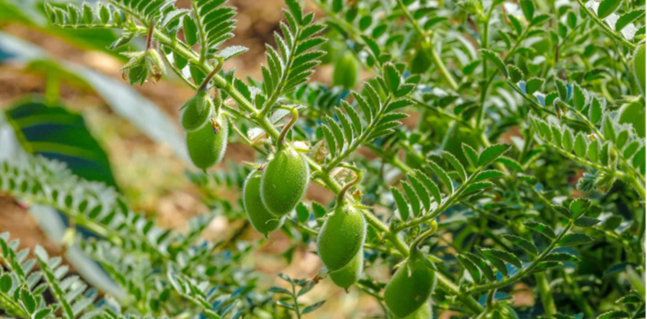
Photo Credits: Harvest to Table
Producers
–
General Information
- Total Area in Serbia: / ha
- Number of Varieties: –
- Family: Fabaceae
- Genus: Cicer
- Species: Cicer arietinum L.
- Product Type: Protein sources
Rotation
Chickpeas fit well in organic rotations with cereals and other legumes. Avoid planting chickpeas after other pulses to reduce disease pressure. Rotating crops helps break pest and pathogen cycles and supports soil fertility through nitrogen fixation.
Preceding Crops
- Preferred: cereals (wheat, barley)
- Avoid: legumes or pest-prone crops
Bed Preparation
- Soil tilled to fine crumb structure for good seed-soil contact
- Weed-free and well-drained beds are essential
- Raised beds improve drainage in heavy soils
Fertilization
- Apply well-rotted compost or manure before sowing
- Inoculate seeds with Mesorhizobium ciceri to enhance nitrogen fixation
- Phosphorus and potassium added based on soil tests
Establishment
- Sow in early spring at 12–15°C soil temperature
- Seed depth: 4–6 cm; Row spacing: 30–40 cm; Plant spacing: 10–15 cm
- Seed rate: 70–100 kg/ha depending on seed size
Care
- Shallow cultivation or hand weeding important before canopy closure
- Moderate drought tolerance, but moisture is critical during flowering
- Manage pod borers and aphids with organic methods (barriers, biocontrol)
- Incorporate residues to maintain soil organic matter
Irrigation
- Usually not required, but flowering may need supplemental water in dry climates
- Avoid overwatering to reduce risk of disease and lodging
Harvest
- Harvest when pods are brown and seeds hard
- Manual or mechanical harvest followed by drying (moisture <12%)
- Proper storage prevents mold and insect damage
Faba Bean

Photo Credits: Crop Trust
Producers
–
General Information
- Total Area in Serbia: / ha
- Number of Varieties: 1
- Family: Fabaceae
- Genus: Vicia
- Species: Vicia faba L.
- Product Type: Protein sources
Rotation
Faba bean is a valuable legume in organic rotations due to its nitrogen-fixing capacity. It is typically rotated with cereals, oilseeds, and root crops to improve soil fertility and break disease cycles. Avoid consecutive legume cultivation to reduce risks of soil-borne pathogens.
Preceding Crops
- Ideal: cereals (wheat, barley, oats)
- Avoid: legumes or crops with similar pest profiles
Bed Preparation
- Deep plowing and harrowing for loose, well-drained seedbed
- Remove perennial weeds; ensure good root penetration
- Raised beds recommended for heavy soils
Fertilization
- Apply compost or well-rotted manure before sowing
- Inoculate with Rhizobium leguminosarum if new to area
- Phosphorus and potassium applied as per soil test
Establishment
- Sow in early spring or late autumn (climate dependent)
- Seed depth: 6–8 cm; Row spacing: 40–50 cm; Plant spacing: 10–20 cm
- Seed rate: 150–250 kg/ha depending on seed size
Care
- Weed early by hoeing or mechanical cultivation
- Susceptible to chocolate spot, rust, aphids
- Use resistant varieties and organic biological controls
- Monitor especially for black aphids during flowering
Irrigation
- Mostly rainfed, but irrigation helps during flowering and pod fill
- Excess water can promote disease; maintain balance
Harvest
- Harvest when pods turn black/brown and seeds are dry
- Manual or mechanical harvest followed by drying
- Store grains below 14% moisture
Lentil

Photo Credits: Better Homes & Gardens
Producers
–
General Information
- Total Area in Serbia: / ha
- Number of Varieties: –
- Family: Fabaceae
- Genus: Lens
- Species: Lens culinaris Medik.
- Product Type: Protein sources
Rotation
Lentils are well-suited to organic crop rotation systems as nitrogen-fixing legumes. They are typically rotated with cereals such as wheat, barley, or oats to improve soil health and reduce pest and disease pressure. Avoid frequent planting of legumes on the same field to minimize root rot and wilt diseases.
Preceding Crops
- Preferred: cereals (wheat, barley, oats)
- Avoid: legumes or crops with similar diseases
Bed Preparation
- Till soil to a fine, firm seedbed with good drainage
- Level and weed-free bed is important
- Minimal tillage possible if soil is healthy and weed-free
Fertilization
- Apply compost or organic manure based on soil needs
- Lentils fix nitrogen and require little external N input
- Inoculate with Rhizobium leguminosarum to boost nodulation
Establishment
- Sow early spring when soil is >5°C
- Depth: 3–6 cm; Row spacing: 20–30 cm; Plant spacing: 5–10 cm
- Seed rate: 40–70 kg/ha
Care
- Weed early using flame or mechanical weeding
- Diseases: rust, anthracnose, aphids
- Manage with resistant varieties, rotation, and biologicals
Irrigation
- Usually rainfed; may benefit from irrigation during flowering and pod fill
- Avoid waterlogging — lentils are sensitive to excess moisture
Harvest
- Harvest when plants yellow and pods are dry
- Manual or mechanical harvest, followed by drying
- Dry to < 13% moisture for safe storage
Soy
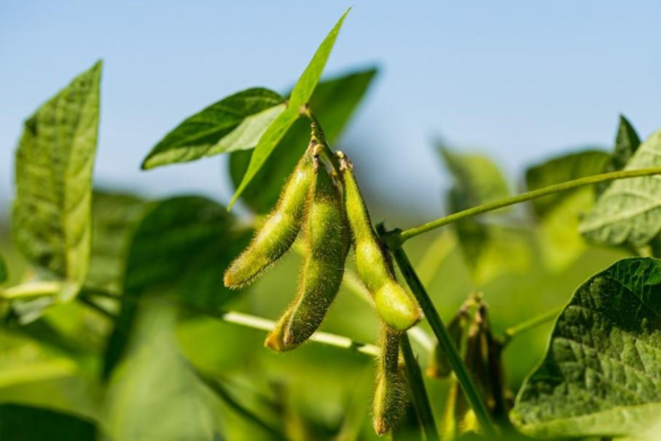
Photo Credits: Plantura Garden
Producers
–
General Information
- Total Area in Serbia: 517 ha
- Number of Varieties: 149
- Family: Fabaceae
- Genus: Glycine
- Species: Glycine max L.
- Product Type: Protein sources
Rotation
Soybean is an important legume in organic crop rotations for nitrogen fixation and soil health. It is rotated with cereals like maize and wheat or root crops to manage pests and improve yields. Avoid growing soybean after other legumes to reduce disease risk.
Preceding Crops
- Preferred: cereals or low-residue vegetables
- Avoid: crops that compact soil or carry over root diseases
Bed Preparation
- Soil should be well-drained, finely tilled, and weed-free
- Raised beds are used in heavy soils
- pH should be near neutral
Fertilization
- Apply compost or manure before sowing if needed
- Inoculation with Bradyrhizobium japonicum is essential
- Use phosphorus and potassium based on soil test
Establishment
- Sow in late spring (soil temperature 10–12°C)
- Depth: 3–5 cm; Row spacing: 45–75 cm; Plant spacing: 5–10 cm
- Seed rate: 60–80 kg/ha
Care
- Control weeds early with mechanical methods
- Soy is sensitive to weed competition
- Monitor for aphids, stink bugs, and leaf feeders
- Control diseases like mildew and white mold through spacing, rotation, and biocontrol
Irrigation
- Irrigate during flowering and pod filling in dry conditions
- Avoid excess moisture and waterlogging
Harvest
- Harvest when pods are brown and seeds rattle (13–15% moisture)
- Mechanical or manual harvesting
- Dry to below 13% moisture for storage
Arugula

Photo Credits: The Spruce
Producers
–
General Information
- Total Area in Serbia: ha
- Number of Varieties: –
- Family: vegetable
- Genus: Eruca
- Species: Eruca vesicaria (L.) Cav.
- Product Type: vegetable
Rotation
Arugula is included in short-cycle organic rotations and intercropped systems. It is rotated with legumes, root vegetables, or cereals to reduce pest and disease pressure. Avoid continuous cultivation of Brassicaceae to prevent buildup of clubroot and flea beetles.
Preceding Crop
- Preferred: legumes and green manure crops
- Avoid: Brassica species or crops prone to similar pests
Bed Preparation
- Soil should be finely tilled to a shallow, smooth, level seedbed
- Good drainage is required
- Raised or flat beds can be used depending on irrigation
Fertilization
- Apply compost or organic manure before sowing
- Leafy vegetables need more nitrogen – top dressing is recommended
- Use compost teas or organic liquid feeds during growth
Establishment
- Sow in early spring or autumn
- Row spacing: 15–20 cm, depth: 0.5–1 cm
- Seed rate: 3–6 kg/ha
Care
- Frequent shallow cultivation or hand weeding is required
- Use row covers to protect from flea beetles
- Crop is sensitive to heat and may bolt
- Organic pest control: neem, diatomaceous earth, pyrethrin
Irrigation
- Regular irrigation is required for tender leaf growth
- Overhead or drip irrigation may be used
- Avoid water stress to prevent early bolting
Harvest
- Baby leaves: harvest in 20–30 days by cutting above growing point
- Mature leaves: harvested individually or whole plant
- Successive sowings extend harvest window
Beetroot
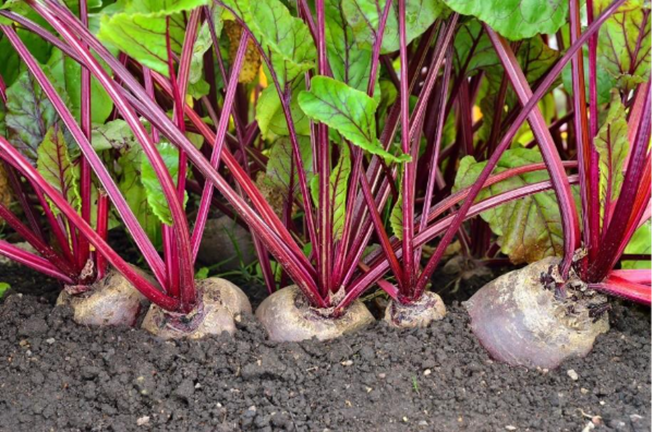
Photo Credits: Plantura
Producers
–
General Information
- Total Area in Serbia: ha
- Number of Varieties: 18
- Family: Amaranthaceae
- Genus: Beta
- Species: Beta vulgaris L.
- Product Type: vegetable
Rotation
Beetroot fits well in diverse organic rotations and is often grown after legumes or cereals. It should not follow other Beta crops to prevent the spread of soil-borne diseases such as rhizoctonia or nematodes. Longer rotations with unrelated crops help manage pests and improve soil health.
Preceding Crop
- Preferred: legumes, cereals, green manure crops
- Avoid: other Beta crops and heavy-feeding species
Bed Preparation
- Deeply loosened and finely tilled soil
- Level, clod-free, and weed-free seedbed
- Raised beds recommended in heavier soils
Fertilization
- Well-rotted compost or organic manure before sowing
- Balanced nutrition, especially P and K based on soil tests
- Avoid excess nitrogen to maintain root quality
Establishment
- Direct sowing in early spring
- Depth: 1–2 cm; Row spacing: 25–40 cm; Plant spacing: 5–10 cm
- Seed rate: 8–10 kg/ha
Care
- Early weeding (mechanical or hand)
- Thinning is essential for uniform root size
- Leaf miner and aphid control with covers or biologicals
- Crop rotation and tolerant varieties for disease management
Irrigation
- Critical during dry spells for even growth
- Avoid overwatering to prevent splitting and poor flavor
Harvest
- Baby beets: 6–8 weeks after sowing
- Mature beets: 10–12 weeks after sowing
- Harvest manually or mechanically; store in cool, dark place
Broccoli
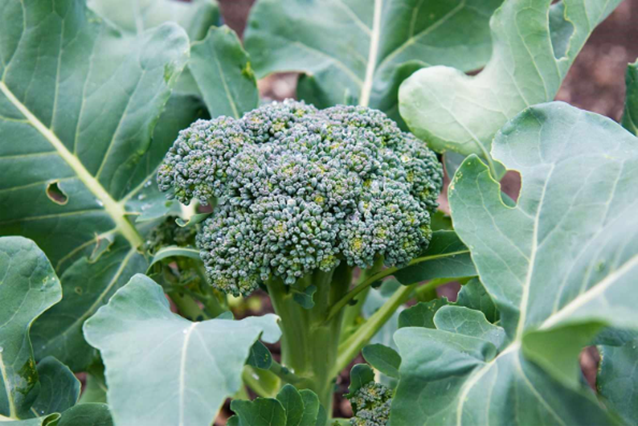
Photo Credits: Martha Stewart
Producers
–
General Information
- Total Area in Serbia: 0.7 ha
- Number of Varieties: 23
- Family: Brassicaceae
- Genus: Brassica
- Species: Brassica oleracea L. var. italica
- Product Type: vegetable
Rotation
Broccoli is rotated with non-Brassica crops to prevent buildup of soil-borne diseases such as clubroot and black rot. It fits well after legumes, cereals, or root crops in organic systems. Avoid back-to-back Brassica crops within 3–4 years.
Preceding Crop
- Preferred: legumes, cereals
- Avoid: other Brassicas
Bed Preparation
- Well-structured, deeply tilled soil enriched with organic matter
- Level, weed-free bed is essential
- Ensure good drainage to prevent root disease
Fertilization
- High-quality compost or aged manure before planting
- Nitrogen-rich organic fertilizers (e.g., fish meal, plant compost)
- Monitor boron and calcium to avoid deficiencies
Establishment
- Sow in trays and transplant after 4–6 weeks or direct sow
- Spring and autumn planting preferred
- Spacing: 40–50 cm between plants, 60–70 cm between rows
Care
- Regular weeding early on (manual or mechanical)
- Use row covers and biologicals for cabbage moths, flea beetles, aphids
- Crop rotation and spacing reduce disease risk
- Mulching retains moisture and suppresses weeds
Irrigation
- Consistent moisture is vital during head formation
- Drip irrigation preferred to avoid disease from wet foliage
Harvest
- Harvest compact heads before buds open
- Cut central head manually with a knife
- Secondary side shoots may follow after main harvest
Cabbage
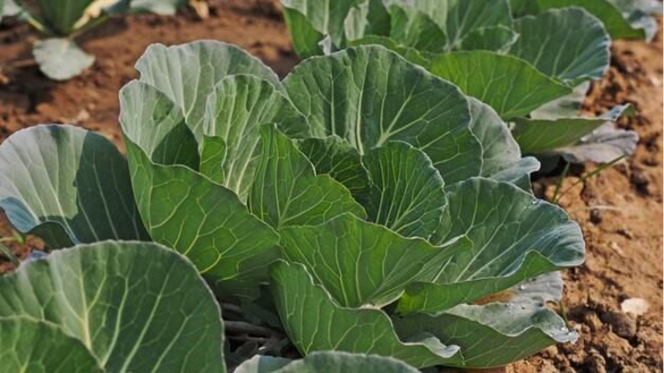
Photo Credits: Freepik
Producers
–
General Information
- Total Area in Serbia: – ha
- Number of Varieties: 115
- Family: Brassicaceae
- Genus: Brassica
- Species: Brassica oleracea L. var. capitata
- Product Type: vegetable
Rotation
Cabbage must be rotated with non-Brassica crops for at least 3–4 years to avoid buildup of pests like cabbage root maggot and diseases like clubroot. Common rotation partners include cereals (barley, oats), legumes (clover, peas), and root crops (carrots, beets). Green manure crops like buckwheat or vetch may also be integrated.
Preceding Crop
- Preferred: legumes, cereals
- Avoid: Brassicas and heavily manured crops
Bed Preparation
- Plow and harrow to 25–30 cm depth, fine and firm seedbed
- Soil must be well-drained, pH 6.2–7.0
- Raised beds recommended in heavy rainfall areas
Fertilization
- High nitrogen and potassium demand during head formation
- 25–30 t/ha of well-rotted manure or compost before planting
- Top-dress with compost tea, nettle or comfrey extract mid-season
- Ensure adequate boron and calcium levels
Establishment
- Start in seedbeds or modules 5–6 weeks before transplanting
- Spring sowing in late winter; autumn sowing in summer
- Spacing: 40–60 cm between plants, 60–70 cm between rows
Care
- Mechanical and manual weed control; mulch with straw or foil
- Row covers/netting to exclude butterflies, moths, beetles
- Bt and neem oil allowed for organic pest control
- Rotate crops, use resistant varieties to manage diseases
Irrigation
- Consistent moisture crucial, especially during head formation
- Drip irrigation preferred to avoid wet foliage
- Avoid both drought and excessive moisture
Harvest
- Harvest when heads are firm and full-sized
- Early varieties: 60–80 days after transplanting
- Late varieties: 100–130 days
- Cut heads manually, leave 2–3 wrapper leaves for protection
- Storage types cured in field before cool storage (0–1°C, 90–95% RH)
Melon

Photo Credits: Amazon.co.uk
Producers
–
General Information
- Total Area in Serbia: 16.18 ha
- Number of Varieties: 28
- Family: Cucurbitaceae
- Genus: Cucumis
- Species: Cucumis melo L.
- Product Type: vegetable
Rotation
Melon is rotated with cereals, legumes, or leafy greens to break pest and disease cycles. Avoid growing melon after other cucurbits like cucumber, pumpkin, or zucchini for at least 3 years. Rotation helps reduce fusarium wilt, downy mildew, and nematodes.
Preceding Crop
- Preferred: legumes (beans, peas) – nitrogen fixers
- Avoid: cucurbits and heavy-feeders
Bed Preparation
- Deeply loosened soil, enriched with compost or green manure
- Raised beds or ridges recommended in heavier soils
- Fine, weed-free seedbed for good germination or transplanting
Fertilization
- Apply 30–40 t/ha of compost or manure pre-planting
- Balanced fertilization with emphasis on potassium
- Use bone meal, liquid extracts, and test soil for boron/magnesium
Establishment
- Direct sowing above 15°C or transplants started 3–4 weeks prior
- Spacing: 100–150 cm between rows, 60–90 cm between plants
Care
- Hoeing or mechanical weeding early; mulch helps retain moisture
- Row covers support early growth and pest exclusion
- Pests: aphids, thrips, whiteflies, cucumber beetles → controlled by neem oil, insecticidal soap, beneficial insects
- Diseases: powdery/downy mildew, fusarium → controlled with resistant varieties and biocontrols
- Optional: vine pruning or training for better airflow and harvest access
Irrigation
- Consistent watering in early stages; avoid wet foliage
- Reduce irrigation before harvest to concentrate sugars
- Drip irrigation highly recommended
Harvest
- Harvest at physiological maturity depending on variety
- Indicators: color change, aroma, easy stem detachment (slip stage)
- Manual harvest preferred to avoid bruising
- Store in cool, dry place; sell quickly due to perishability
Carrot
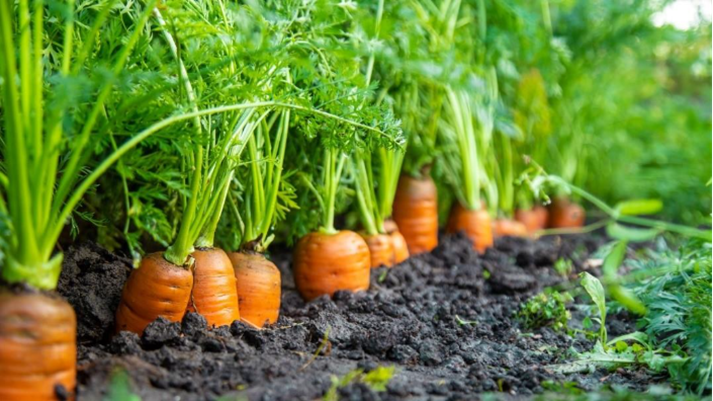
Photo Credits: botanicalinterests.com
Producers
–
General Information
- Total Area in Serbia: ha
- Number of Varieties: 47
- Family: Apiaceae
- Genus: Daucus
- Species: Daucus carota L.
- Product Type: vegetable
Rotation
Carrots are rotated with cereals, legumes, or leafy crops to break cycles of soil-borne diseases and nematodes. Avoid growing carrots after other Apiaceae crops such as parsley or celery for at least 3 years. Rotations including green manures like clover or buckwheat improve soil structure and reduce weed pressure.
Preceding Crop
- Ideal: legumes and cereals that improve soil aeration and suppress weeds
- Avoid: crops that require deep tillage just before carrot sowing
Bed Preparation
- Finely tilled, loose, and stone-free soil up to 30 cm depth
- Raised beds preferred in heavy soils to improve drainage
- Level, firm, clod-free seedbed ensures uniform root development
Fertilization
- Apply 20–30 t/ha of mature compost well in advance of sowing
- Fresh manure is not recommended as it may cause root forking
- Balance phosphorus and potassium levels, avoid nitrogen excess
- Organic sources like rock phosphate or potassium sulfate may be used
Establishment
- Direct sowing in early spring when soil > 7°C
- Sow 1–2 cm deep; row spacing 20–30 cm; intra-row 2–6 cm
- Seed rate: 4–8 kg/ha depending on variety and market type
Care
- Slow emergence → weed control is critical in early stages
- Use stale seedbed and flame weeding pre-emergence
- Thin seedlings post-emergence for proper spacing
- Carrot fly managed with row covers, intercropping (onion/leek)
- Fungal disease like Alternaria managed by rotation and spacing
- Mulching helps retain moisture and suppress weeds
Irrigation
- Essential during germination and uniform root development
- Drip irrigation preferred to avoid crusting and foliar diseases
- Consistent moisture avoids splitting and misshapen roots
Harvest
- Harvest time: 60–75 days for baby carrots, 90–130 days for mature
- Manual or mechanical harvest depending on scale
- Roots gently loosened and pulled, then washed
- Storage carrots harvested in cool weather and stored at 0–1°C with high humidity
Cauliflower
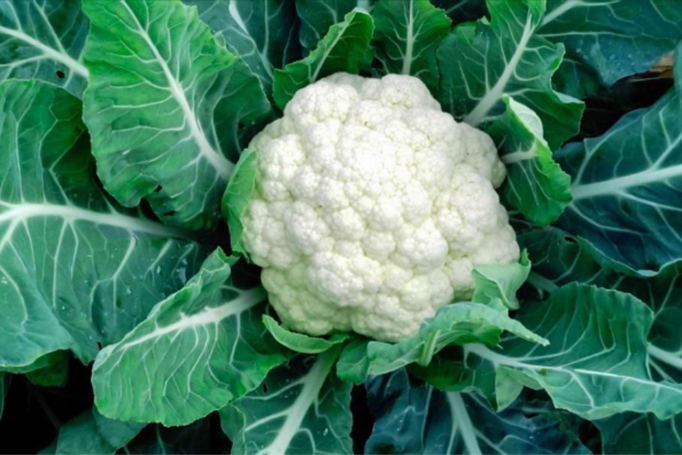
Photo Credits: thespruce.com
Producers
–
General Information
- Total Area in Serbia: 0.44 ha
- Number of Varieties: 43
- Family: Brassicaceae
- Genus: Brassica
- Species: Brassica oleracea L. var. botrytis
- Product Type: vegetable
Rotation
Cauliflower must be rotated with non-Brassica crops for at least 3–4 years to avoid buildup of pests such as cabbage root fly and diseases like clubroot. It is commonly rotated with legumes, cereals, and leafy crops to improve soil health and reduce disease pressure.
Preceding Crop
- Ideal: legumes or grasses that improve soil fertility
- Avoid: other Brassicas or crops that increase pathogen risk
Bed Preparation
- Soil must be deeply cultivated, well-drained, rich in organic matter
- pH: 6.5 to 7.5
- Fine tilth and level beds for uniform transplanting
- Raised beds recommended in heavy soils
Fertilization
- Apply 30–35 t/ha of well-rotted compost/manure before transplanting
- Additional nitrogen and potassium needed during curd development
- Use organic-approved sources like compost tea, feather meal, etc.
- Monitor boron and molybdenum to avoid hollow stems and curd defects
Establishment
- Seeds sown in trays or beds 4–6 weeks before transplanting
- Spring: sow Feb–Mar → transplant April
- Autumn: sow June–July → transplant mid-late summer
- Spacing: 40–60 cm between plants, 60–80 cm between rows
Care
- Frequent weeding during early growth
- Pests: cabbage white butterfly, aphids, flea beetles – managed with netting, neem, Bt
- Diseases: black rot, downy mildew – managed with rotation, spacing, copper-based sprays
- Some varieties require tying leaves to protect curd from sun
Irrigation
- Regular irrigation during transplant establishment and curd formation
- Keep soil consistently moist, avoid waterlogging
- Drip irrigation preferred to reduce disease risk
Harvest
- Harvest when heads are compact, white, and fully formed
- Manual harvest with knife, leaving protective leaves
- Early types: 60–80 days; late types: up to 120 days
- Store cool and sell quickly to retain quality
Celery
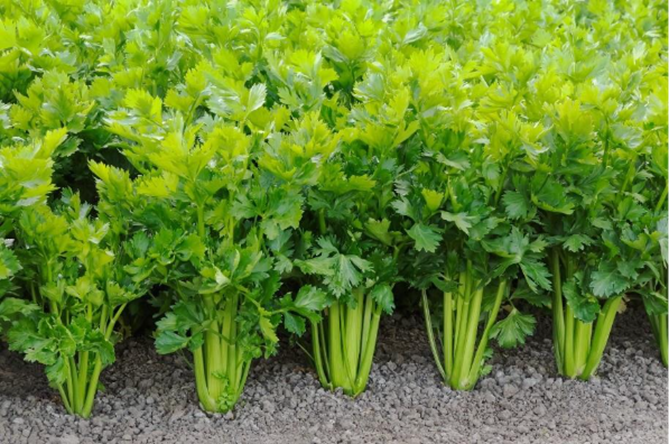
Photo Credits: npr.org
Producers
–
General Information
- Total Area in Serbia: –
- Number of Varieties: 19
- Family: Apiaceae
- Genus: Apium
- Species: Apium graveolens L.
- Product Type: vegetable
Rotation
Celery is rotated with non-Apiaceae crops for at least 3–4 years to avoid buildup of soil-borne diseases and nematodes. Suitable rotation crops include cereals, legumes, and leafy greens. Avoid planting after carrot, parsley, or parsnip due to similar pest profiles.
Preceding Crop
- Preferred: legumes and cereals for soil improvement and weed suppression
- Avoid: nutrient-depleting or pest-sharing crops
Bed Preparation
- Deep cultivation (30–35 cm), good drainage, high organic matter
- Fine, level seedbed with good moisture retention
- Optimal pH: 6.2 to 7.0
Fertilization
- Apply 35–40 t/ha of compost or manure 4+ weeks before planting
- High nitrogen, potassium, and calcium demand
- Use compost tea, nettle extract, pelleted manure during growth
- Correct boron and magnesium as needed to avoid defects
Establishment
- Sow seeds in nursery beds or modules 8–10 weeks before transplanting
- Sowing: Feb–Mar (spring crops), June–July (autumn crops)
- Requires light and warmth for germination
- Spacing: 25–30 cm between plants, 40–50 cm between rows
Care
- Weed control via hoeing and mulching
- Drip irrigation essential to prevent stress and stringy stalks
- Very sensitive to drought, especially mid to late stages
- Pests: aphids, carrot fly, leaf miner, thrips – managed with nets and plant extracts
- Fungal diseases (e.g. Septoria) controlled via rotation and air circulation
- Optional: earthing-up to blanch stalks
Irrigation
- Consistent and generous irrigation required
- Drip irrigation preferred to protect foliage and ensure quality
Harvest
- Harvest 90–120 days after transplanting, when stalks are thick and crisp
- Manual harvest: cut at base, remove outer leaves
- Wash, bundle, and cool immediately after harvest
- Storage: 0–1°C and high humidity for several weeks
Chard
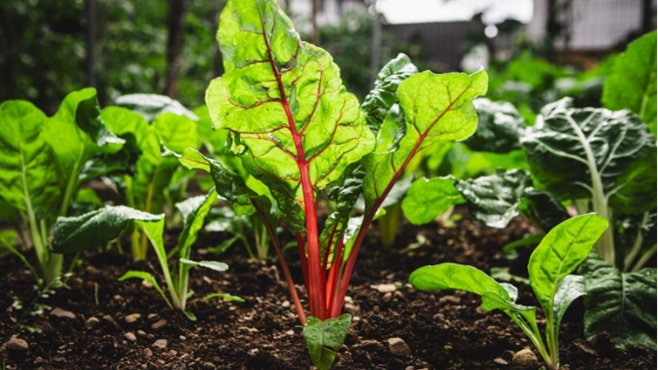
Photo Credits: Homes and Gardens
Producers
–
General Information
- Total Area in Serbia: 1.62 ha
- Number of Varieties: 4
- Family: Amaranthaceae
- Genus: Beta
- Species: Beta vulgaris subsp. vulgaris
- Product Type: vegetable
Rotation
Chard is rotated with legumes, brassicas, or cereals to reduce soil-borne disease risk. Avoid rotation with other beet crops such as sugar beet or red beet due to pest overlap.
Preceding Crop
- Best: legumes or low-residue crops that enrich the soil
- Avoid: heavy feeders or crops causing compaction (e.g., corn, potato)
Bed Preparation
- Deeply loosened, well-drained soil with good organic content
- Fine, moist seedbed free of clods
- Optimal pH: 6.5–7.5
Fertilization
- 20–25 t/ha of compost or manure pre-planting
- Moderate, steady nitrogen supply is key
- Optional foliar feeding after first harvest (e.g., compost tea)
- Ensure balanced potassium and magnesium
Establishment
- Direct sowing when soil reaches 8–10°C in spring
- Depth: 2–3 cm
- Spacing: 30–40 cm rows × 20–30 cm plants for mature harvest
- For baby leaf: dense sowing, 200–300 seeds/m²
- Transplants: ready after 4–5 weeks for early/late season
Care
- Early weeding important due to slow initial growth
- Mulching helps retain moisture and suppress weeds
- Harvest outer leaves for continuous picking
- Pests: leaf miners, aphids, flea beetles – managed by row covers and plant extracts
- Fungal leaf spots managed with spacing, teas, and rotation
Irrigation
- Regular irrigation ensures leaf quality and tenderness
- Drip irrigation recommended to prevent foliar disease
- Avoid drought to prevent bolting or bitterness
Harvest
- Baby leaves: 30–40 days after sowing
- Mature leaves: 50–60 days after sowing
- Cut outer leaves by hand or knife, preserving central crown
- Store at 0–4°C with high humidity for short-term use
Cucumber

Photo Credits: Epic Gardening
Producers
–
General Information
- Total Area in Serbia: 0.28 ha
- Number of Varieties: 85
- Family: Cucurbitaceae
- Genus: Cucumis
- Species: Cucumis sativus L.
- Product Type: vegetable
Rotation
Cucumbers are rotated with cereals, legumes, or leafy crops every 3–4 years to avoid pest and disease buildup. Avoid rotating with other cucurbits (squash, melon, pumpkin) to prevent Fusarium and mildew problems.
Preceding Crop
- Ideal: legumes, brassicas (for nitrogen fixation and pest suppression)
- Avoid: other cucurbits like zucchini or melon
Bed Preparation
- Deep cultivation, well-drained soil, rich in organic matter
- Raised beds/ridges preferred in heavy soils to avoid root rot
- Optimal pH: 6.0–7.0
Fertilization
- Apply 20–30 t/ha compost or manure 3–4 weeks pre-planting
- Use potassium- and phosphorus-rich fertilizers for fruiting
- Liquid manures or compost teas applied during growth
Establishment
- Direct sowing when soil >15°C, or transplant after 3–4 weeks
- Row spacing: 1.2–2.0 m; Plant spacing: 30–50 cm depending on system
- Protected cultivation (tunnels): transplant in April–May
- Open-field sowing starts mid–late May
Care
- Use trellises or nets for vine support
- Weed control: mechanical cultivation and organic mulch
- Tying and pruning needed in greenhouses/high tunnels
- Pests: cucumber beetle, aphids, mites – managed with neem, nets, or beneficial insects
- Diseases (mildew): controlled by spacing, resistant varieties, and sulfur-based treatments
Irrigation
- Essential during flowering and fruit set
- Drip irrigation preferred to reduce foliar disease risk
- Consistent watering prevents cracking or bitterness
Harvest
- Start 40–60 days after sowing
- Harvest every 2–3 days to encourage yield
- Pick uniform-sized fruits gently to avoid damage
- Store at 10–12°C with high humidity for short-term freshness
Garlic
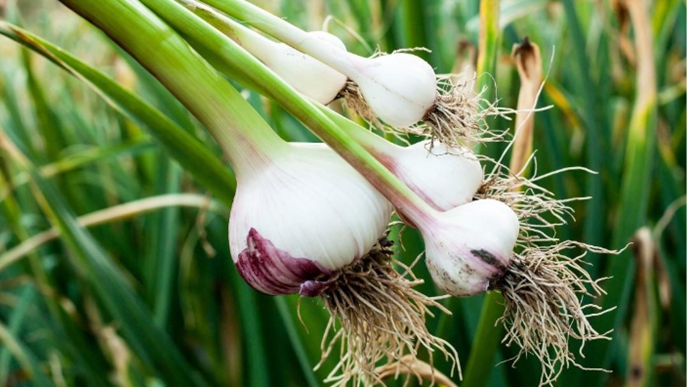
Photo Credits: Patch
Producers
–
General Information
- Total Area in Serbia: 2.64 ha
- Number of Varieties: 7
- Family: Amaryllidaceae
- Genus: Allium
- Species: Allium sativum L.
- Product Type: vegetable
Rotation
Garlic must be rotated every 4–5 years with non-Allium crops like legumes or cereals to prevent white rot and nematodes. Avoid onion, leek, or other Alliums in preceding years.
Preceding Crop
- Best: Legumes (improve nitrogen and structure)
- Avoid: Root-pathogen-prone crops or heavy feeders
Bed Preparation
- Deep plowing and fine cultivation (25–30 cm)
- Soil: loamy or sandy loam, well-drained, high in organic matter
- pH: 6.5–7.2
- Raised beds recommended for wet conditions
Fertilization
- 25–30 t/ha well-rotted manure or compost 3–4 weeks before planting
- Avoid fresh manure
- Balanced phosphorus and potassium needed for bulb development
- Foliar feeding (e.g., seaweed extract) during spring vegetative stage
Establishment
- Planting: mid-Oct to early Nov (autumn garlic); spring garlic possible but lower yield
- Use disease-free cloves (3–5 g)
- Spacing: 5–7 cm deep, 8–10 cm in-row, 25–30 cm between rows
- Do not separate bulbs too early before planting
Care
- Critical weeding during first 6–8 weeks
- Mulch for frost protection and weed suppression
- Remove flower stalks (scapes) unless harvested as product
- Monitor rust, mildew, white rot – use rotation, hygiene, copper/sulfur sprays
- Sensitive to waterlogging
Irrigation
- Consistent moisture during early growth and bulb formation
- Reduce or stop watering 2–3 weeks before harvest
- Use drip irrigation for efficiency and disease prevention
Harvest
- When 50–70% of leaves yellow, typically June–early July
- Lift bulbs carefully with forks
- Cure for 2–3 weeks in shade with airflow
- Store at 0–4°C (low humidity) for long-term, or ambient short-term
Green Beans
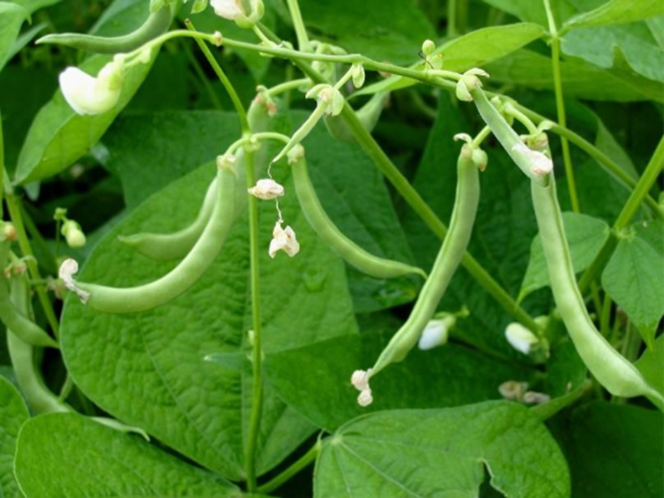
Photo Credits: The Arbor Gate
Producers
–
General Information
- Total Area in Serbia: 0.36 ha
- Number of Varieties: 53
- Family: Fabaceae
- Genus: Phaseolus
- Species: Phaseolus vulgaris L.
- Product Type: vegetable
Rotation
Rotate green beans with cereals, root crops, or leafy vegetables to prevent disease buildup. Avoid successive bean plantings to reduce viral and fungal disease risk.
Preceding Crop
- Best: Cereals like wheat or barley
- Avoid: Other legumes (risk of nitrogen surplus and disease)
Bed Preparation
- Deep plowing and fine tillage (20–25 cm)
- Fertile, well-drained soil with organic matter
- Level, clod-free beds for uniform germination
Fertilization
- 15–20 t/ha of compost or manure before sowing
- Beans fix nitrogen—moderate N needed
- Focus on phosphorus and potassium for flowering and pod development
- Correct deficiencies with organic fertilizers if needed
Establishment
- Sow at 12–15°C soil temperature
- 3–5 cm planting depth
- Row spacing: 40–50 cm; plant spacing: 8–12 cm (bush types)
- Pole beans require wider spacing and vertical supports
Care
- Weed control: mulching or mechanical hoeing
- Pest control: monitor for aphids, beetles, miners; treat with neem or insecticidal soap
- Disease prevention: crop rotation, resistant varieties, organic fungicides
- Trellising improves air circulation for climbing types
Irrigation
- Even moisture during flowering and pod development
- Drip irrigation is ideal to minimize foliar diseases
- Avoid water stress to preserve yield and pod quality
Harvest
- Pick when pods are firm and seeds immature
- Harvest every 2–3 days to encourage ongoing production
- Hand-picking reduces plant and pod damage
- Store at 7–10°C with high humidity for freshness
Kohlrabi

Photo Credits: Wikipedia
Producers
–
General Information
- Total Area in Serbia: 0.29 ha
- Number of Varieties: 6
- Family: Brassicaceae
- Genus: Brassica
- Species: Brassica oleracea var. gongylodes
- Product Type: vegetables
Rotation
Kohlrabi should be rotated with non-brassica crops like legumes, cereals, or root crops to avoid buildup of diseases such as clubroot or black rot.
Preceding Crop
- Best: Legumes and cereals for improved nitrogen and soil structure
- Avoid: Brassicas or solanaceous crops (e.g. tomato, pepper)
Bed Preparation
- Deep tillage and fine tilth preparation
- Loamy, well-drained soil with pH 6.0–7.5
- Free of weeds and well-leveled beds
Fertilization
- 20–30 t/ha of compost or rotted manure incorporated before planting
- Supplement with organic phosphorus and potassium based on soil analysis
- Optional: liquid organic side-dressing during early development
Establishment
- Can be direct sown or transplanted
- Sowing depth: 1–2 cm
- Spacing: 40–50 cm between rows, 20–25 cm between plants
- Transplants at 3–4 leaf stage improve uniformity and yield
Care
- Weed control by shallow hoeing and organic mulching
- Regular irrigation especially during bulb formation
- Monitor for pests: aphids, flea beetles, cabbage worms — control with biocontrol and botanicals
- Diseases: rotation and resistant varieties recommended
Irrigation
- Consistent moisture without waterlogging
- Drip irrigation is ideal to reduce foliar disease
Harvest
- Harvest when bulb diameter is 5–8 cm
- Do not allow over-maturity as texture becomes woody
- Cut at soil level or gently pull up
- Store at 0–2°C with high humidity for freshness
Leek
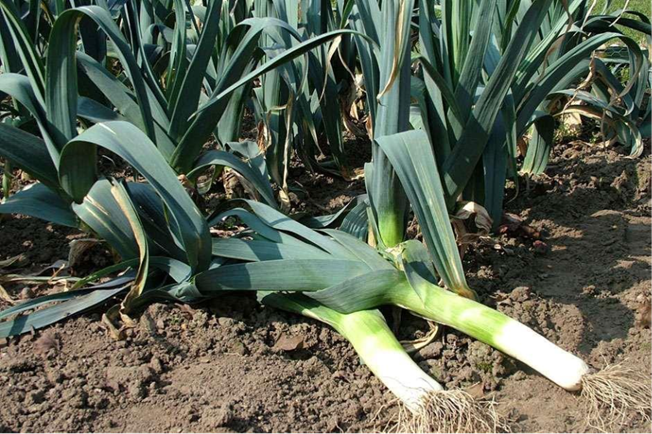
Photo Credits: RHS Vegetables
Producers
–
General Information
- Total Area in Serbia: – ha
- Number of Varieties: 3
- Family: Amaryllidaceae
- Genus: Allium
- Species: Allium ampeloprasum var. porrum
- Product Type: vegetable
Rotation
Leeks are rotated with cereals, legumes, or root vegetables to minimize soil-borne diseases such as white rot and reduce pest pressure from leek moth.
Preceding Crop
- Ideal: Legumes, cereals
- Avoid: Allium crops (onion, garlic, etc.)
Bed Preparation
- Deep tillage to 25–30 cm
- Well-drained, fertile soil
- Fine, clod-free seedbed
- Raised beds or ridges to improve drainage
Fertilization
- Apply 25–30 t/ha of compost or rotted manure pre-planting
- Supplement with phosphorus and potassium based on soil analysis
- Nitrogen-rich organic side-dressing (e.g. fish emulsion) supports growth
Establishment
- Seeds started indoors 8–10 weeks before transplanting
- Transplant with 6–8 true leaves
- Spacing: 15–20 cm between plants; 30–40 cm between rows
- Deep planting encourages blanching of stems
Care
- Weed control with mulch or shallow cultivation
- Earthing-up helps blanch stems and improves quality
- Pest control: Leek moth, thrips, aphids managed with neem, soaps, biocontrol
- Disease control: rotation, sanitation, and resistant varieties
Irrigation
- Consistent moisture required for steady growth
- Avoid waterlogging
- Drip irrigation preferred for disease prevention
Harvest
- Harvest when stems reach 2.5–4 cm diameter
- Typically 90–120 days after transplanting
- Loosen soil before pulling
- Store at 0–4°C and high humidity for several weeks
Lettuce

Photo Credits: Martha Stewart
Producers
–
General Information
- Total Area in Serbia: – ha
- Number of Varieties: 112
- Family: Asteraceae
- Genus: Lactuca
- Species: Lactuca sativa L.
- Product Type: vegetable
Rotation
Rotate with cereals, legumes, or root crops to reduce disease pressure from soil-borne pathogens. Avoid Asteraceae family crops to minimize risk of downy mildew and sclerotinia.
Preceding Crop
- Ideal: Early-harvested legumes or grains that leave soil loose and clean
- Avoid: Heavy nitrogen-feeding crops
Bed Preparation
- Well-drained, loamy soil rich in organic matter
- Finely tilled to 20–25 cm depth
- pH between 6.0–6.8
- Flat or raised seedbeds based on climate
Fertilization
- Apply 20–30 t/ha of compost or manure before planting
- Supplement with organic nitrogen sources like compost teas
- Balance potassium and phosphorus according to soil test
- Avoid excessive nitrogen to prevent soft growth and disease
Establishment
- Direct sow or transplant depending on type and season
- Sow seeds 0.5–1 cm deep
- Spacing: 25–30 cm between rows; 20–30 cm in-row for heads
- Transplant at 4–5 leaf stage after 3–4 weeks in nursery
Care
- Frequent shallow cultivation or organic mulch to control weeds
- Use floating row covers for pest control and microclimate
- Manage aphids, slugs, and leaf miners with barriers and sprays
- Promote airflow and spacing to prevent disease
Irrigation
- Maintain steady, moderate moisture to avoid tip burn and bitterness
- Use drip or early-morning overhead irrigation
- Avoid stress, especially during head formation
Harvest
- Harvest when heads are firm and full, before bolting
- Loose-leaf types: harvest outer leaves continuously
- Cut heads at soil line in the morning for best quality
- Cool immediately and store at 0–4°C with high humidity
Okra

Photo Credits: Martha Stewart
Producers
–
General Information
- Total Area in Serbia: – ha
- Number of Varieties: –
- Family: Malvaceae
- Genus: Abelmoschus
- Species: Abelmoschus esculentus L.
- Product Type: Vegetable
Rotation
Rotate with cereals or legumes to reduce buildup of soil pests and diseases. Avoid Malvaceae crops such as cotton to prevent common pest issues like root-knot nematodes.
Preceding Crop
- Ideal: Maize, wheat — improve structure and reduce weeds
- Avoid: Heavy feeders without proper soil amendment
Bed Preparation
- Deep tilling and well-drained soil with high organic matter
- Soil pH 6.0–6.8
- Raised beds/ridges recommended for better root development
Fertilization
- 20–30 t/ha of compost or manure before planting
- Add rock phosphate and wood ash as needed
- Side-dress with compost tea or nettle extract during early flowering
Establishment
- Soak seeds 12–24 h before sowing
- Sow directly 2–3 cm deep when soil is >18°C
- Spacing: 30–40 cm within rows; 60–75 cm between rows
- Thin after emergence if necessary
Care
- Weed control: shallow hoeing or mulch in early stages
- Remove old leaves and shoots to improve air circulation
- Pests: aphids, whiteflies, flea beetles, fruit borers
- Disease: powdery mildew, wilt — managed by resistant varieties and crop rotation
Irrigation
- Regular watering essential during flowering and pod formation
- Okra dislikes waterlogged soil
- Drip irrigation is most efficient
Harvest
- Begin harvest 5–7 days after flowering
- Harvest every 2–3 days while pods are tender
- Use gloves to avoid skin irritation
- Store at 8–10°C with high humidity for short-term freshness
Onion
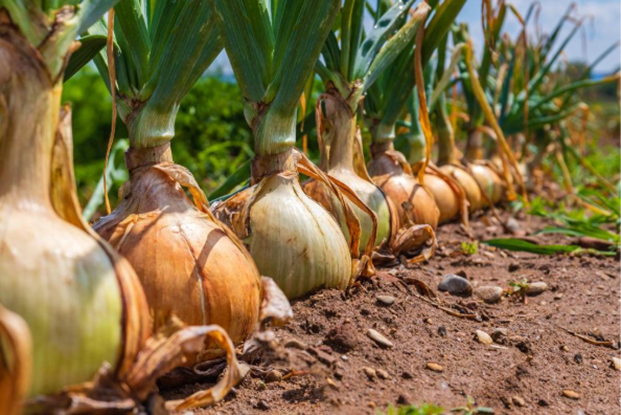
Photo Credits: Ugaoo
Producers
–
General Information
- Total Area in Serbia: – ha
- Number of Varieties: 68
- Family: Amaryllidaceae
- Genus: Allium
- Species: Allium cepa L.
- Product Type: Vegetable
Rotation
Rotate with non-Allium crops every 3–4 years to reduce risk of pests and diseases. Avoid garlic, leek, or chive as previous crops to prevent buildup of onion maggot, thrips, and white rot.
Preceding Crop
- Ideal: Legumes, cereals, or leafy vegetables with well-managed nutrition
- Avoid: Heavy residue crops or nutrient-depleting crops
Bed Preparation
- Deep tillage to 25–30 cm
- Well-drained loamy or sandy loam soil with pH 6.0–7.0
- Raised beds are preferred in wet areas to prevent waterlogging
Fertilization
- Apply 25–35 t/ha of compost or well-rotted manure
- Supplement phosphorus and potassium organically
- Side-dress with nitrogen-rich organic inputs during early bulb formation
Establishment
- Establish from seeds, sets, or seedlings depending on system
- Transplant seedlings at 4–6 leaf stage: 10–12 cm in-row, 25–30 cm between rows
- Direct sowing depth: 1–2 cm; soil temp >10°C
Care
- Weed regularly with shallow hoeing or mulching
- Pests: thrips, onion fly — control with neem oil, traps, row covers
- Diseases: downy mildew, purple blotch, white rot — manage with rotation, spacing, and resistant varieties
Irrigation
- Moderate but consistent irrigation, especially during bulb development
- Avoid overhead watering to reduce fungal risks
- Stop irrigation 2–3 weeks before harvest for better curing
Harvest
- Harvest when 60–80% of tops fall and necks soften
- Pull and cure in shaded, ventilated space for 10–14 days
- Store at 0–2°C, dry and ventilated to avoid sprouting or rotting
Paprika

Photo Credits: luv2garden.com
Producers
–
General Information
- Total Area in Serbia: – ha
- Number of Varieties: 214
- Family: Solanaceae
- Genus: Capsicum
- Species: Capsicum annuum L.
- Product Type: Vegetable
Rotation
Rotate paprika with cereals, legumes, or brassicas every 3–4 years to prevent buildup of soil-borne diseases and pests. Avoid rotation with tomato, potato, and eggplant (Solanaceae).
Preceding Crop
- Ideal: Legumes like beans and peas
- Avoid: Tomato, potato, or any other Solanaceae crops
Bed Preparation
- Deep tillage and fine bed preparation for healthy root development
- Loamy, well-drained soil with pH 6.0–6.8
- Raised beds or ridges improve drainage and harvesting
Fertilization
- Apply 25–30 t/ha compost or well-rotted manure before transplanting
- Use bone meal, wood ash, or other organic phosphorus and potassium sources
- Side-dress during flowering and fruiting with compost tea or fermented plant extracts
Establishment
- Start seedlings 6–8 weeks before field transplanting
- Sow seeds 0.5–1 cm deep in trays with rich substrate
- Transplant at 4–6 leaf stage when soil temps >15°C
- Spacing: 40–50 cm in-row, 60–70 cm between rows
Care
- Weed manually or mechanically, especially early
- Mulch to retain moisture and reduce weeds
- Stake plants to prevent stem breakage from heavy fruit
- Common pests: aphids, thrips, spider mites, fruit borers
- Diseases: bacterial spot, fusarium wilt, powdery mildew — managed with resistant varieties and crop rotation
Irrigation
- Maintain regular moisture, especially during flowering and fruit set
- Drip irrigation is preferred to reduce disease risk
- Avoid moisture fluctuations to prevent blossom-end rot
Harvest
- Harvest 70–90 days after transplanting when fruits reach full color and firmness
- Harvest regularly to promote continued production
- Fully ripe red fruits are harvested for drying
- Store in cool, dry, and pest-free areas or grind into powder post-drying
Parsnip
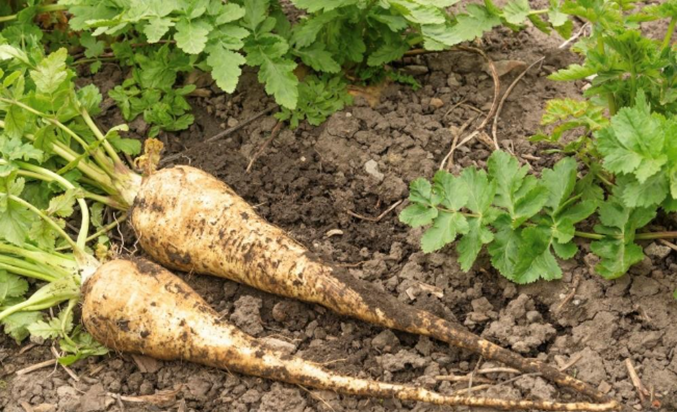
Photo Credits: Plantura
Producers
–
General Information
- Total Area in Serbia: – ha
- Number of Varieties: 7
- Family: Apiaceae
- Genus: Pastinaca
- Species: Pastinaca sativa L.
- Product Type: Vegetable
Rotation
Include parsnip in a 4–5 year rotation with cereals and legumes to reduce soil-borne diseases. Avoid other Apiaceae crops such as carrots, parsley, and celery.
Preceding Crop
- Ideal: Legumes or early-harvested cereals
- Avoid: Crops hosting nematodes or soil-borne pathogens
Bed Preparation
- Deep, loose, and stone-free soil for straight root growth
- Preferred soil: Loamy or sandy-loam with pH 6.0–7.0
- Deep plowing and fine tilth are essential
Fertilization
- Apply 20–30 t/ha of well-rotted compost during preparation
- Avoid fresh manure (causes forking)
- Supplement with organic potassium and phosphorus as needed
Establishment
- Direct sowing only (parsnip doesn't transplant well)
- Sow early spring, 1.5–2 cm deep
- Row spacing: 30–40 cm; thin to 8–10 cm between plants
- Slow germination — up to 3 weeks
Care
- Weed regularly using shallow cultivation or mulching
- Do not disturb roots when weeding
- Pests: aphids, carrot root fly, occasional fungal leaf spots
- Prevent diseases through airflow and rotation
Irrigation
- Regular irrigation during dry periods is essential
- Avoid overwatering to prevent root rot
- Reduce watering before harvest to enhance root firmness
Harvest
- Harvest 120–180 days after sowing (late autumn)
- Frost improves flavor and sweetness
- Lift carefully to avoid breaking roots
- Store in cool, humid sand boxes for several months
Pumpkin
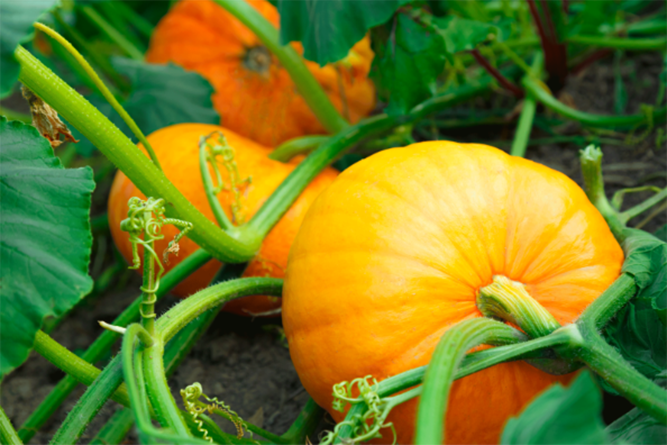
Photo Credits: Ugaoo
Producers
–
General Information
- Total Area in Serbia: – ha
- Number of Varieties: 1
- Family: Cucurbitaceae
- Genus: Cucurbita
- Species: Cucurbita pepo L.
- Product Type: Vegetable
Rotation
Rotate pumpkin in a 3–4 year cycle with non-Cucurbit crops like cereals or legumes to reduce pest and disease pressure. Avoid rotation with other cucurbits such as cucumbers, melons, or zucchinis.
Preceding Crop
- Ideal: Cereals and legumes (e.g., maize, beans)
- Avoid: Other cucurbits and heavy feeders
Bed Preparation
- Loose, fertile, well-drained soil (pH 6.0–6.8)
- Deep tillage to 30 cm
- Incorporate organic matter during bed prep
- Use raised beds or ridges to improve drainage
Fertilization
- Apply 30–40 t/ha of well-rotted manure or compost
- Supplement with organic phosphorus and potassium (e.g., rock phosphate, wood ash)
- Use compost tea or fermented extracts during flowering
Establishment
- Direct sowing when soil temperature is 15–18°C
- Sow 2–3 seeds per hill, 3–5 cm deep
- Thin to the strongest plant
- Spacing: 100–120 cm within rows, 150–200 cm between rows
Care
- Weed control by hoeing or mulching in early stages
- Train vines to avoid overcrowding
- Monitor for squash bugs, aphids, cucumber beetles
- Use neem oil, garlic spray, or trap crops
- Watch for powdery mildew; encourage airflow
Irrigation
- Regular watering during flowering and fruit set
- Drip irrigation preferred to reduce moisture on foliage
- Reduce watering before harvest to improve quality and shelf life
Harvest
- Harvest when skin is hard and full color is reached
- Cut with shears, leaving a portion of the stem
- Cure in a dry, ventilated space for 10–14 days
- Store at 10–15°C in dry conditions for long-term storage
Radish

Photo Credits: Seed Parade
Producers
–
General Information
- Total Area in Serbia: – ha
- Number of Varieties: 26
- Family: Brassicaceae
- Genus: Raphanus
- Species: Raphanus sativus L.
- Product Type: Vegetable
Rotation
Rotate radish with cereals and legumes every 3–4 years to reduce buildup of soil-borne pests and diseases. Avoid rotation with Brassicas to minimize risk of clubroot, downy mildew, and flea beetles.
Preceding Crop
- Ideal: Cereals, legumes
- Avoid: Other Brassicas, heavy feeders
Bed Preparation
- Well-drained, loose, organic-rich soil
- Deep tillage and fine seedbed
- Optimal pH: 6.0–7.0
Fertilization
- Apply 20–25 t/ha of well-rotted compost or manure
- Avoid fresh manure (prevents root deformities)
- Add potassium and phosphorus if needed based on soil test
Establishment
- Direct sowing from early spring to autumn
- Seed depth: 1–2 cm
- Row spacing: 15–25 cm
- Thin to 4–6 cm between plants
Care
- Control weeds early using hoeing or mulching
- Monitor pests: flea beetles, aphids, root maggots
- Use row covers, neem treatments if needed
- Ensure good airflow to prevent fungal diseases
Irrigation
- Consistent moisture ensures even root development
- Avoid waterlogging (risk of root rot)
- Drip irrigation recommended
Harvest
- Ready 25–45 days after sowing (depending on variety)
- Harvest when roots reach optimal size before becoming woody
- Lift gently to avoid breaking roots
- Store at 0–2°C, high humidity for short-term use
Spinach

Photo Credits: Happy Valley Seeds
Producers
–
General Information
- Total Area in Serbia: – ha
- Number of Varieties: 33
- Family: Amaranthaceae
- Genus: Spinacia
- Species: Spinacia oleracea L.
- Product Type: Vegetable
Rotation
Rotate spinach with legumes, cereals, or root crops every 3–4 years to reduce buildup of diseases and pests. Avoid other leafy greens as they may share pathogens.
Preceding Crop
- Ideal: Cereals, legumes
- Avoid: Leafy greens with high nitrogen demand or heavy residues
Bed Preparation
- Fertile, well-drained loamy soil with pH 6.5–7.5
- Fine seedbed with shallow tillage and organic matter
- Raised or flat beds depending on site moisture
Fertilization
- Apply 20–30 t/ha of well-rotted compost or manure
- High nitrogen demand for leafy growth—use compost tea or fermented nettle extract
- Phosphorus and potassium added as needed per soil analysis
Establishment
- Direct sowing in early spring or late summer
- Seed depth: 1.5–2.5 cm
- Row spacing: 20–30 cm; thin seedlings to 5–10 cm within rows
Care
- Weed regularly, especially during seedling stage
- Mulch to conserve moisture and suppress weeds
- Monitor for downy mildew, aphids, leaf miners
- Use neem extract, resistant varieties, and beneficial insects
Irrigation
- Maintain consistent moisture to prevent bolting and ensure tenderness
- Avoid water stress and waterlogging
- Prefer drip or furrow irrigation to avoid wet leaves
Harvest
- Harvest 30–50 days after sowing
- Harvest by cutting outer leaves or entire rosettes
- Wash and cool immediately after harvest
- Store at 0–2°C with high humidity for short-term storage
Tomato

Photo Credits: Bonnie Plants
Producers
–
General Information
- Total Area in Serbia: – ha
- Number of Varieties: 205
- Family: Solanaceae
- Genus: Solanum
- Species: Solanum lycopersicum L.
- Product Type: Vegetable
Rotation
Include tomato in a 3–4 year rotation with legumes, cereals, or root crops to prevent soil-borne diseases. Avoid rotating with Solanaceae family members like peppers, potatoes, and eggplants.
Preceding Crop
- Prefer: Legumes or cereals
- Avoid: Nitrogen-depleting crops or Solanaceae hosts
Bed Preparation
- Deep, fertile, well-drained soil (pH 6.0–7.0)
- Raised beds or ridges for drainage and strong root growth
- Incorporate compost and manure into top 20–30 cm
Fertilization
- 30–40 t/ha of well-rotted organic manure or compost
- Use bone meal, wood ash, or natural rock phosphorus and potassium sources
- Apply compost tea or fermented extracts during flowering and fruiting
Establishment
- Start seedlings 6–8 weeks before field transplant
- Seed depth: 0.5–1 cm
- Transplant at 4–6 leaf stage after frost risk
-
Spacing:
Determinate: 40–50 cm within rows, 80–100 cm between rows
Indeterminate: 60 cm within rows, 100–120 cm between rows
Care
- Stake or trellis to improve air circulation and prevent fruit-soil contact
- Prune suckers in indeterminate types to concentrate fruiting
- Mulch to suppress weeds and conserve moisture
- Watch for: aphids, whiteflies, hornworms, spider mites
- Prevent blight and leaf spots with copper fungicides and airflow
Irrigation
- Deep, regular watering during flowering and fruiting
- Use drip irrigation or water at base to avoid wetting leaves
- Reduce watering near maturity to improve flavor and minimize cracking
Harvest
- Ready 60–90 days after transplant depending on variety
- Pick ripe fruits for fresh use or slightly underripe for transport
- Store at 12–15°C; do not refrigerate to preserve flavor
Watermelon

Photo Credits: BBC Gardeners’ World
Producers
–
General Information
- Total Area in Serbia: – ha
- Number of Varieties: 100
- Family: Cucurbitaceae
- Genus: Citrullus
- Species: Citrullus lanatus (Thunb.) Matsum. & Nakai
- Product Type: Vegetable
Rotation
Rotate in a 3–5 year cycle with cereals, legumes, or root crops to prevent pest/disease buildup. Avoid rotation with cucurbits (cucumber, squash, melon, etc.).
Preceding Crop
- Prefer: Grains or legumes (improve nitrogen and soil texture)
- Avoid: Heavy feeders or crops with similar pest/disease risks
Bed Preparation
- Deep, sandy-loam, well-drained soils (pH 6.0–6.8)
- Loosen soil to 30–40 cm with compost and aged manure
- Form raised beds or ridges for drainage and soil warmth
Fertilization
- Apply 30–40 t/ha of compost or manure before sowing
- Supplement with organic P and K (e.g., rock phosphate, wood ash)
- Use fermented nettle or comfrey extract during flowering/fruiting
Establishment
- Sow directly when soil ≥ 16–18°C or transplant seedlings (3–4 weeks old)
- Sow 2–3 seeds per hill at 2–3 cm depth, thin to 1 strong plant
- Spacing: 1.5–2.0 m between rows, 0.8–1.2 m within row
Care
- Weed early and often; use mulch
- Train vines for better light and airflow
- Watch for: aphids, thrips, beetles, spider mites
- Use neem oil or garlic spray as needed
- Prevent fungal diseases with airflow, spacing, and rotation
Irrigation
- Water consistently from germination to fruit set
- Deep irrigation once or twice per week; avoid wetting leaves
- Reduce watering during fruit ripening to boost sugar and flavor
Harvest
- Ready when tendril near fruit dries, ground spot turns yellow, and it sounds hollow
- Matures 75–100 days after sowing
- Harvest carefully to prevent bruising
- Store at 10–15°C with 85–90% humidity
Wild Garlic

Photo Credits: A Food Forest in your Garden
Producers
–
General Information
- Total Area in Serbia: – ha
- Number of Varieties: –
- Family: Amaryllidaceae
- Genus: Allium
- Species: Allium ursinum L.
- Product Type: Vegetable
Rotation
While often foraged, wild garlic can be cultivated in forest gardens or shaded agroforestry systems. Rotate cultivation sites every few years to allow regeneration and reduce disease risk.
Preceding Crop
- Prefer: Shade-tolerant crops that improve organic matter (e.g., legumes, leafy greens)
- Avoid: Heavy feeders or crops that disturb soil structure
Bed Preparation
- Rich, moist, humus-rich soils with pH 5.5–7.0
- Incorporate compost and leaf mold for fertility
- Maintain shaded/semi-shaded conditions similar to woodland floor
Fertilization
- Apply well-rotted compost or leaf mold yearly
- Avoid synthetic fertilizers to preserve soil biology and product integrity
Establishment
- Propagated by bulb division or young plant transplanting
- Seeds can be sown in autumn or spring (slow germination)
- Plant bulbs or seedlings 5–10 cm deep, 15–20 cm apart
Care
- Maintain soil moisture during dry periods
- Manual weeding without disturbing shallow roots
- Mulch with leaf litter to retain moisture and cool temperature
- Avoid disturbance during dormancy to support regrowth cycle
Irrigation
- Water regularly to maintain moist but not waterlogged soil
- Ensure drainage to prevent bulb rot
Harvest
- Harvest leaves in early spring before flowering
- Cut outer leaves to allow regrowth; avoid harvesting entire plant
- Do not harvest bulbs from wild populations
- Store in cool, humid conditions or dry quickly for preservation
Zucchini
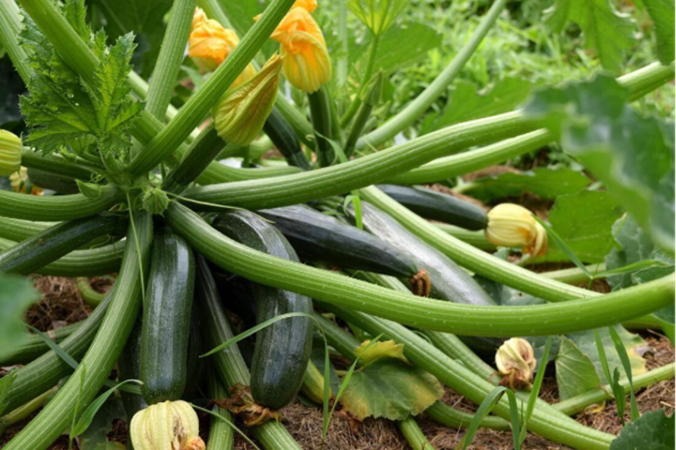
Photo Credits: Maine Garden Ideas
Producers
–
General Information
- Total Area in Serbia: – ha
- Number of Varieties: 33
- Family: Cucurbitaceae
- Genus: Cucurbita
- Species: Cucurbita pepo L.
- Product Type: Vegetable
Rotation
Include zucchini in a 3–4 year crop rotation with cereals, legumes, or root crops to reduce pest and disease buildup. Avoid planting zucchini after other cucurbits to prevent soil-borne diseases.
Preceding Crop
- Prefer: Legumes or cereals for better nitrogen and soil structure
- Avoid: Heavy feeders or cucurbits with shared pest profiles
Bed Preparation
- Fertile, well-drained loam with pH 6.0–6.8
- Deep tillage and addition of compost or manure
- Use raised beds or ridges for drainage and warmth
Fertilization
- Apply 25–35 t/ha of well-composted manure before planting
- Supplement P & K based on soil test (e.g., bone meal, wood ash)
- Use fermented plant extracts for additional growth support
Establishment
- Sow seeds 2–3 cm deep in warm soil (>18°C) or transplant seedlings
- Spacing: 80–100 cm within rows, 1.2–1.5 m between rows
Care
- Regular irrigation to keep soil moist (not soggy)
- Frequent weeding and mulching to conserve moisture
- Monitor and manage: squash bugs, aphids, mildew (organic methods)
- Remove infected leaves promptly
Irrigation
- Consistent moisture needed during flowering and fruit set
- Avoid overhead irrigation to reduce disease risk
- Drip irrigation is ideal
Harvest
- Harvest when fruits are 15–20 cm long
- Pick every 2–3 days to encourage production
- Store at 10–12°C with high humidity for short-term storage
Potato
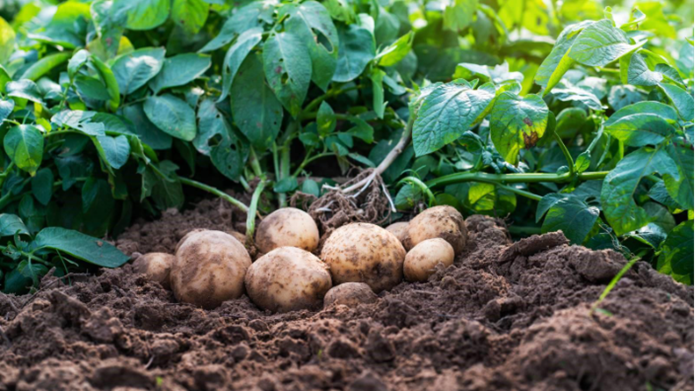
Photo Credits: Gardening Know How
Producers
–
General Information
- Total Area in Serbia: 8.28 ha
- Number of Varieties: 109
- Family: Solanaceae
- Genus: Solanum
- Species: Solanum tuberosum L.
- Product Type: Vegetable
Rotation
Practice a 4–5 year crop rotation to reduce pest and disease pressure. Avoid planting potatoes after other Solanaceae crops such as tomatoes, peppers, or eggplants.
Preceding Crop
- Prefer: Legumes, cereals, or cover crops to improve soil health
- Avoid: Repeated planting of potatoes to reduce soil-borne issues
Bed Preparation
- Well-drained loamy or sandy soils, pH 5.0–6.5
- Deep plowing and harrowing to loosen soil
- Apply 30–40 t/ha of compost or manure
- Form ridges or raised beds for tuber development
Fertilization
- Use compost, manure, bone meal, and rock phosphate as per soil analysis
- Wood ash can supplement potassium
- Apply compost tea or fermented extracts during growth
Establishment
- Use certified seed tubers, cut into pieces with eyes
- Plant 10–15 cm deep, 30 cm apart in rows 70–90 cm apart
- Plant when soil reaches 7–10°C
Care
- Hill soil around stems to promote tuber growth and block light
- Control weeds manually or with mulch
- Monitor for Colorado beetle, aphids, wireworms, nematodes
- Use crop rotation, natural predators, neem, and copper fungicides
Irrigation
- Ensure consistent moisture during tuber initiation and bulking
- Avoid waterlogging
- Drip irrigation reduces foliar disease risk
Harvest
- Harvest when foliage dies back (90–120 days)
- Lift tubers carefully, avoid damage
- Cure for 1–2 weeks in cool, dark, humid area
- Store at 4–6°C in dark, ventilated space
Rucola (Arugula)

Photo Credits: Holmes Seed Company
Producers
General Information
- Total Area in Serbia: – ha
- Number of Varieties: –
- Family: Brassicaceae
- Genus: Eruca
- Species: Eruca vesicaria (L.) Cav.
- Product Type: Vegetable
Rotation
Include rucola in a 3-year crop rotation to reduce pest and disease risks. Avoid planting near other Brassicaceae crops to prevent clubroot and fungal issues.
Preceding Crop
- Recommended: Legumes or root crops
- To Avoid: Brassicaceae or other leafy greens
Bed Preparation
- Well-drained, fertile soil with pH 6.0–7.0
- Incorporate organic compost or aged manure into the top 20 cm
- Smooth and level bed for uniform germination
Fertilization
- Use compost or manure before planting
- Boost growth with liquid organic fertilizers or fermented plant extracts
- Avoid excess nitrogen to prevent poor flavor
Establishment
- Direct sow in spring or autumn, 0.5–1 cm deep
- Row spacing: 15–20 cm; Thin to 5–10 cm between plants
- Sow every 2–3 weeks for continuous harvest
Care
- Keep soil moist but not waterlogged
- Regular weeding by hand or shallow cultivation
- Mulch helps retain moisture and suppress weeds
- Control pests (flea beetles, aphids, fungi) with neem or insecticidal soap
Irrigation
- Water regularly to maintain even moisture
- Avoid overhead irrigation to reduce fungal diseases
Harvest
- Harvest leaves when 10–15 cm tall
- Cut outer leaves or entire plant
- Use fresh or store at 1–4°C with high humidity for up to 1 week
